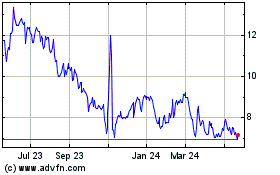false 0001501796 0001501796 2023-11-06 2023-11-06
UNITED STATES
SECURITIES AND EXCHANGE COMMISSION
WASHINGTON, D.C. 20549
FORM 8-K
CURRENT REPORT
Pursuant to Section 13 or 15(d)
of the Securities Exchange Act of 1934
Date of Report (Date of earliest event reported): November 6, 2023
Aura Biosciences, Inc.
(Exact name of Registrant as Specified in Its Charter)
|
|
|
|
|
| Delaware |
|
001-40971 |
|
32-0271970 |
(State or Other Jurisdiction
of Incorporation) |
|
(Commission File Number) |
|
(IRS Employer
Identification No.) |
|
|
|
|
|
| 80 Guest Street Boston, Massachusetts |
|
|
|
02135 |
| (Address of Principal Executive Offices) |
|
|
|
(Zip Code) |
Registrant’s Telephone Number, Including Area Code: 617 500-8864
Not Applicable
(Former Name or Former Address, if Changed Since Last Report)
Check the appropriate box below if the Form 8-K filing is intended to simultaneously satisfy the filing obligation of the registrant under any of the following provisions:
| ☐ |
Written communications pursuant to Rule 425 under the Securities Act (17 CFR 230.425) |
| ☐ |
Soliciting material pursuant to Rule 14a-12 under the Exchange Act (17 CFR 240.14a-12) |
| ☐ |
Pre-commencement communications pursuant to Rule 14d-2(b) under the Exchange Act (17 CFR 240.14d-2(b)) |
| ☐ |
Pre-commencement communications pursuant to Rule 13e-4(c) under the Exchange Act (17 CFR 240.13e-4(c)) |
Securities registered pursuant to Section 12(b) of the Act:
|
|
|
|
|
| Title of each class |
|
Trading
Symbol(s) |
|
Name of each exchange on which registered |
| Common Stock, $0.00001 par value per share |
|
AURA |
|
The Nasdaq Global Market |
Indicate by check mark whether the registrant is an emerging growth company as defined in Rule 405 of the Securities Act of 1933 (§ 230.405 of this chapter) or Rule 12b-2 of the Securities Exchange Act of 1934 (§ 240.12b-2 of this chapter).
Emerging growth company ☒
If an emerging growth company, indicate by check mark if the registrant has elected not to use the extended transition period for complying with any new or revised financial accounting standards provided pursuant to Section 13(a) of the Exchange Act. ☐
| Item 7.01. |
Regulation FD Disclosure. |
AAO 2023 Annual Meeting Data Release
On November 6, 2023, Aura Biosciences, Inc. (the “Company”) presented positive clinical efficacy updates of belzupacap sarotalocan (“bel-sar”) for early stage choroidal melanoma (“CM”) with suprachoroidal (“SC”) administration at the American Academy of Ophthalmology (“AAO”) 2023 Annual Meeting. The Company issued a press release announcing these and other updates titled “Aura Biosciences Receives FDA Agreement Under Special Protocol Assessment (SPA) for CoMpass Phase 3 Clinical Trial of Belzupacap Sarotalocan (Bel-sar) in Early-stage Choroidal Melanoma.” A copy of the press release is furnished herewith as Exhibit 99.1 and is incorporated herein by reference.
In connection with these updates, the Company updated its corporate presentation for use in meetings with investors, analysts and others. A copy of the corporate presentation is furnished herewith as Exhibit 99.2 and is incorporated herein by reference.
The information furnished under this Item 7.01, including Exhibits 99.1 and 99.2 hereto, shall not be deemed “filed” for purposes of Section 18 of the Securities Exchange Act of 1934, as amended (the “Exchange Act”), or otherwise subject to the liabilities of that section, nor shall it be deemed incorporated by reference in any filing under the Securities Act of 1933, as amended, or the Exchange Act, except as expressly set forth by specific reference in such a filing.
AAO 2023 Annual Meeting Data Release
On November 6, 2023, the Company announced that it has received agreement from the United States Food and Drug Administration (“FDA”) under a Special Protocol Assessment (“SPA”) for the design and planned analysis of CoMpass, the Company’s global Phase 3 clinical trial of bel-sar for the first-line treatment of adult patients with early-stage CM. The Company also announced the presentation of positive Phase 2 safety and efficacy data of bel-sar with 90% of patients at twelve months of follow-up evaluating two key clinical endpoints: tumor control and visual acuity preservation using SC route of administration for the first-line treatment of adult patients with early-stage CM. The results were presented at the AAO 2023 Annual Meeting, in San Francisco, California.
The Company received written agreement from the FDA under an SPA for the design and planned analysis of the Global Phase 3 CoMpass trial indicating concurrence by the FDA with the adequacy of the study, if successful, to address the objectives necessary to support the Company’s planned biologics license application submission. The Phase 3 trial is designed as a superiority trial comparing bel-sar versus sham. The trial is a global, multi-center, masked study, and it is intended to enroll approximately 100 patients randomized 2:1:2 to receive high dose regimen of bel-sar with SC administration, low dose regimen of bel-sar with SC administration, or a sham control. The primary endpoint is time to tumor progression, and the first key secondary endpoint is a composite time to event analysis that will compare the tumor control and visual acuity of the bel-sar high dose regimen to sham when the last patient completes their 15 months of follow up. The trial is powered at greater than 90%. The Company is on track to dose the first patient in the fourth quarter of 2023.
The Phase 2 trial is assessing the safety and preliminary efficacy of single- and multiple ascending-doses of bel-sar up to three cycles of treatment via SC administration for the first-line treatment of early-stage CM. A total of 22 adult patients have been enrolled in the trial including the single dose Cohorts 1-3 (n=6) and multiple dose escalation Cohorts 4-6 (n=16). Cohorts 5 and 6 (n=13) received up to three cycles of therapy, which was considered the therapeutic regimen for evaluation. One patient in Cohort 5 (n=3) received two cycles of therapy and two patients in Cohort 5 received three cycles of therapy (40 µg/dose). All patients from Cohort 6 (n=10) were assigned to receive three cycles of therapy at the highest dose (80 µg/dose). One patient from Cohort 6, who discontinued after one cycle due to unrelated serious adverse events (“SAEs”), is not included in the analysis. All patients in Cohorts 5 and 6 had active tumor growth at study entry, as an enrichment strategy to evaluate preliminary efficacy. This group of patients with active growth treated at the therapeutic regimen of three cycles was evaluated for tumor control, visual acuity preservation and tumor growth rate as the defined clinical endpoints to evaluate preliminary efficacy. The results, with 90% of patients at twelve months of follow-up who received three cycles of therapy in Cohorts 5 and 6, and who match the criteria for the global Phase 3 trial, showed a tumor control rate of 80% (8/10) and the visual acuity preservation rate was 90% (9/10). The majority of patients being at high-risk for vision loss with tumors close to the fovea or optic disk. For the 80% of patients that responded, data showed a statistically significant reduction in tumor growth rate (-0.382 mm/yr, p = <0.0001) compared to each patient’s documented growth rate at study entry. The overall tolerability profile of bel-sar was favorable, with no dose-limiting toxicities, treatment-related SAEs or significant AEs reported as of August 3, 2023. There was no posterior inflammation and only mild anterior inflammation (Grade 1) in approximately 18% of the patients which was self-limited or resolved with a short course of topical steroids. Treatment-related AEs were predominantly mild and resolved without sequalae. The Company believes these updated results indicate that bel-sar may offer a targeted, vision preserving therapy for the first-line treatment of primary CM, where 80% of patients are diagnosed at an early stage and have no approved therapies to date.
Preliminary Data from Phase 1 Trial in Bladder Cancer
On November 6, 2023, the Company announced in a press release that the ongoing Phase 1 trial has completed enrollment of the cohort that received bel-sar injection without light activation. Protocol mandated safety review found no safety issues and the study has proceeded to the bel-sar injection plus light activation cohorts. Preliminary data from the first patient in the light activated cohort of the trial, utilizing a single dose of bel-sar with light activation, demonstrated a clinical complete response demonstrated by absence of cancer cells on histopathology with evidence of extensive necrosis and immune activation.
Bel-sar is a novel investigational agent designed with a dual mechanism of action that includes targeted cytotoxicity and immune activation. The ongoing Phase 1 multi-center, open-label clinical trial is expected to enroll approximately 19 adult patients. The trial is designed to assess the safety and tolerability of bel-sar as a single agent. The trial will provide histopathological evaluation after the local treatment to assess bel-sar’s biological activity. In addition, the FDA has allowed an amendment to the protocol of the Company’s ongoing Phase 1 trial evaluating bel-sar, allowing the inclusion of adult patients with muscle invasive bladder cancer (“MIBC”) in addition to non-muscle invasive bladder cancer (“NMIBC”). The Company expects to provide more data in mid-2024.
Termination of ATM Prospectus
On November 6, 2023, the Company delivered written notice to Jefferies LLC (“Jefferies”) that it was suspending and terminating the prospectus related to the Company’s common stock, $0.00001 par value per share (the “ATM Prospectus”), issuable pursuant to the terms of the Open Market Sale AgreementSM, dated November 1, 2022 (the “Sales Agreement”), by and between the Company and Jefferies. The Company will not make any sales of its securities pursuant to the Sales Agreement, unless and until a new prospectus, prospectus supplement or a new registration statement is filed. Other than the termination of the ATM Prospectus, the Sales Agreement remains in full force and effect.
A copy of the Sales Agreement was filed as Exhibit 1.2 to the Company’s Registration Statement on Form S-3 filed with the U.S. Securities and Exchange Commission (the “SEC”) on November 1, 2022.
Forward Looking Statements
Statements contained under this Item 8.01 regarding matters that are not historical facts are “forward-looking statements” within the meaning of the Private Securities Litigation Reform Act of 1995. Any statements that are not statements of historical fact may be deemed to be forward looking statements. Words such as “may,” “will,” “could”, “should,” “expects,” “intends,” “plans,” “anticipates,” “believes,” “estimates,” “predicts,” “projects,” “seeks,” “endeavor,” “potential,” “continue” or the negative of such words or other similar expressions that can be used to identify. Because such statements are subject to risks and uncertainties, actual results may differ materially from those expressed or implied by such forward-looking statements. Such forward looking statements include express or implied statements regarding Aura’s future expectations, plans and prospects, including, without limitation, statements regarding, but are not limited to, the therapeutic potential of bel-sar for the treatment of cancers including CM, MIBC, NMIBC and choroidal metastasis; any express or implied statements regarding the Company’s expectations for the Phase 2 and Phase 3 clinical trials of bel-sar for early-stage CM and the Phase 1 trial of bel-sar for MIBC and NMIBC; the potential approvability of bel-sar; and the Phase 2 trial of bel-sar for CM.
The forward-looking statements in this press release are neither promises nor guarantees, and investors should not place undue reliance on these forward-looking statements because they involve known and unknown risks, uncertainties, and other factors, many of which are beyond the Company’s control and which could cause actual results to differ materially from those expressed or implied by these forward-looking statements, including, without limitation, uncertainties inherent in clinical trials and in the availability and timing of data from ongoing clinical trials; the expected timing for submissions for regulatory approval or review by governmental authorities; the risk that the results of the Company’s clinical trials may not be predictive of future results in connection with future clinical trials; the risk that interim data from ongoing clinical trials may not be predictive of final data from completed clinical trials; the risk that governmental authorities may disagree with the Company’s clinical trial designs, even where the Company has obtained agreement with governmental authorities on the design of such trials, such as the Phase 3 SPA agreement with FDA; whether the Company will receive regulatory approvals to conduct trials or to market products; whether the Company’s cash resources will be sufficient to fund its foreseeable and unforeseeable operating expenses and capital expenditure requirements; the Company’s ongoing and planned preclinical activities; and the Company’s ability to initiate, enroll, conduct or complete ongoing and planned clinical trials. These risks, uncertainties and other factors include those risks and uncertainties described under the heading “Risk Factors” in the Company’s most recent Annual Report on Form 10-K and Quarterly Report on Form 10-Q filed with the SEC and in subsequent filings made by the Company with the SEC, which are available on the SEC’s website at www.sec.gov. Except as required by law, the Company disclaims any intention or responsibility for updating or revising any forward-looking statements contained in this press release in the event of new information, future developments or otherwise. These forward-looking statements are based on the Company’s current expectations and speak only as of the date hereof and no representations or warranties (express or implied) are made about the accuracy of any such forward-looking statements.
| Item 9.01 |
Financial Statements and Exhibits. |
(d) Exhibits.
SIGNATURES
Pursuant to the requirements of the Securities Exchange Act of 1934, the registrant has duly caused this report to be signed on its behalf by the undersigned thereunto duly authorized.
|
|
|
|
|
|
|
|
|
|
|
|
|
Aura Biosciences, Inc. |
|
|
|
|
| Date: November 6, 2023 |
|
|
|
By: |
|
/s/ Julie Feder |
|
|
|
|
|
|
Julie Feder
Chief Financial Officer |
Exhibit 99.1

Aura Biosciences Receives FDA Agreement Under Special Protocol Assessment (SPA) for CoMpass Phase 3
Clinical Trial of Belzupacap Sarotalocan (Bel-sar) in Early-stage Choroidal Melanoma
Positive Clinical Efficacy
Updates of Bel-sar for Early-Stage Choroidal Melanoma from the Ongoing Phase 2 Clinical Trial with Suprachoroidal Administration Presented at AAO 2023
Preliminary Data from Phase 1 Trial in Bladder Cancer – First Patient Utilizing a Single Dose of Bel-sar with Light Activation
Demonstrated a Clinical Complete Response
BOSTON, MA – November 6, 2023 – Aura Biosciences, Inc. (NASDAQ: AURA),
a clinical-stage biotechnology company developing a novel class of virus-like drug conjugate (VDC) therapies for multiple oncology indications, today announced it has received agreement from the U.S. Food and Drug Administration (FDA) under an SPA
for the design and planned analysis of CoMpass, the Company’s global Phase 3 clinical trial of bel-sar for the first-line treatment of adult patients with early-stage Choroidal Melanoma (CM). The Company also announced the presentation of
positive Phase 2 safety and efficacy data of bel-sar with 90% of patients at twelve months of follow-up evaluating two key clinical endpoints: tumor control and visual acuity preservation using suprachoroidal
(SC) route of administration for the first-line treatment of adult patients with early-stage CM. The results were presented at the American Academy of Ophthalmology (AAO) 2023 Annual Meeting, in San Francisco, California.
“This written agreement from the FDA is consistent with our regulatory strategy and reaffirms that the design and planned analysis of the CoMpass Phase 3
Clinical Trial, if successful, adequately address the objectives necessary to support a biologics license application submission for bel-sar for the treatment of early-stage CM,” said Dr. Jill Hopkins, Chief Medical Officer and President
of R&D of Aura Biosciences. “We are excited with the momentum in the ocular oncology community to participate in what would be the first ever registration-enabling clinical trial for early-stage CM.”
“The Phase 2 data presented today, with 90% of patients at twelve months follow-up, show results that are highly
consistent with and strongly support the assumptions for the design of the CoMpass trial. We have observed 80% tumor control and 90% visual acuity preservation for patients that have been treated with the therapeutic regimen of bel-sar and meet the
Phase 3 enrollment criteria. The safety profile continues to be favorable with no treatment-related Serious Adverse Events or significant Adverse Events. This is very encouraging as most of these patients had tumors close to the fovea or optic disk
and would have likely experienced severe and irreversible vision loss with the current standard of care with radiotherapy,” said Dr. Carol Shields, Chief of the Ocular Oncology Service at Wills Eye Hospital and Professor of Ophthalmology
at Thomas Jefferson University (USA). “We are excited for the possibility to have for the first time a vision preserving therapy, expanding the possibility to treat patients earlier than we do today.”
The presentation can be accessed on the Company’s website here.
Agreement from the FDA Under an SPA for the Global Phase 3 CoMpass Trial:
The Company received written agreement from the FDA under an SPA for the design and planned analysis of the Global Phase 3 CoMpass trial indicating concurrence
by the FDA with the adequacy of the study, if successful, to address the objectives necessary to support the Company’s planned biologics license application submission. The Phase 3 trial is designed as a superiority trial comparing bel-sar
versus sham. The trial is a global, multi-center, masked study, and it is intended to enroll approximately 100 patients randomized 2:1:2 to receive high dose regimen of bel-sar with SC administration, low dose regimen of bel-sar with SC
administration, or a sham control. The primary endpoint is time to tumor progression, and the first key secondary endpoint is a composite time to event analysis that will compare the tumor control and visual acuity of the bel-sar high dose regimen
to sham when the last patient completes their 15 months of follow up. The trial is powered at greater than 90%. The Company is on track to dose the first patient in Q4 2023.
Updated Safety and Efficacy Data from the Phase 2 Trial with SC Administration
The Phase 2 trial (NCT04417530) is assessing the safety and preliminary efficacy of single- and multiple ascending-doses of bel-sar up to three cycles of
treatment via SC administration for the first-line treatment of early-stage CM. A total of 22 adult patients have been enrolled in the trial including the single dose Cohorts 1-3 (n=6) and multiple dose
escalation Cohorts 4-6 (n=16). Cohorts 5 and 6 (n=13) received up to three cycles of therapy, which was considered the therapeutic regimen for evaluation. One patient in Cohort 5 (n=3) received two cycles of
therapy and two patients in Cohort 5 received three cycles of therapy (40 µg/dose). All patients from Cohort 6 (n=10) were assigned to receive three cycles of therapy at the highest dose (80 µg/dose). One patient from Cohort 6, who
discontinued after one cycle due to unrelated serious adverse events (SAEs), is not included in the analysis. All patients in Cohorts 5 and 6 had active tumor growth at study entry, as an enrichment strategy to evaluate preliminary efficacy. This
group of patients with active growth treated at the therapeutic regimen of three cycles was evaluated for tumor control, visual acuity preservation and tumor growth rate as the defined clinical endpoints to evaluate preliminary efficacy. The
results, with 90% of patients at twelve months of follow-up who received three cycles of therapy in Cohorts 5 and 6, and who match the criteria for the global Phase 3 trial, showed a tumor control rate of 80%
(8/10) and the visual acuity preservation rate was 90% (9/10). The majority of patients being at high-risk for vision loss with tumors close to the fovea or optic disk. For the 80% of patients that responded, data showed a statistically significant
reduction in tumor growth rate (-0.382 mm/yr, p = <0.0001) compared to each patient’s documented growth rate at study entry. The overall tolerability profile of bel-sar was favorable, with no
dose-limiting toxicities, treatment-related SAEs or significant AEs reported as of August 3, 2023. There was no posterior inflammation and only mild anterior inflammation (Grade 1) in ~18% of the patients which was self-limited or resolved with
a short course of topical steroids. Treatment-related AEs were predominantly mild and resolved without sequalae. We believe these updated results indicate that bel-sar may offer a targeted, vision preserving therapy for the first-line treatment of
primary CM, where 80% of patients are diagnosed at an early stage and have no approved therapies to date.
Preliminary Data from Phase 1 Trial in Bladder Cancer
The trial has completed enrollment of the cohort that received bel-sar injection without light activation. Protocol mandated safety review found no safety
issues and the study has proceeded to the bel-sar injection plus light activation cohorts. Preliminary data from the first patient in the light activated cohort of the trial, utilizing a single dose of bel-sar with light activation, demonstrated a
clinical complete response demonstrated by absence of cancer cells on histopathology with evidence of extensive necrosis and immune activation.
Bel-sar
is a novel investigational agent designed with a dual mechanism of action that includes targeted cytotoxicity and immune activation. The ongoing Phase 1 multi-center, open-label clinical trial is expected to enroll approximately 19 adult patients.
The trial is designed to assess the safety and tolerability of bel-sar as a single agent. The trial will provide histopathological evaluation after the local treatment to assess bel-sar’s biological activity. In addition, the FDA has allowed an
amendment to the protocol of the Company’s ongoing Phase 1 trial evaluating bel-sar, allowing the inclusion of adult patients with muscle invasive bladder cancer in addition to non-muscle invasive bladder
cancer. The Company expects to provide more data mid-2024.
About Aura Biosciences
Aura Biosciences, Inc. is a clinical-stage biotechnology company developing VDCs, a novel class of therapies, for the treatment of multiple oncology
indications. Aura’s lead VDC candidate, belzupacap sarotalocan (bel-sar; AU-011), consists of a virus-like particle conjugated with an anti-cancer agent. Bel-sar is designed to selectively target and
destroy cancer cells and activate the immune system with the potential to create long-lasting, anti-tumor immunity. Bel-sar is currently in development for ocular cancers, and Aura has initiated activities for the global Phase 3 trial evaluating
first-line treatment of early-stage choroidal melanoma, a vision- and life-threatening form of eye cancer where the standard of care with radiotherapy leaves patients with severe comorbidities, including significant vision loss. Aura plans to pursue
development of bel-sar across its ocular oncology franchise including for the treatment of patients with choroidal metastasis. In addition, leveraging Aura’s technology platform, Aura is developing bel-sar more broadly across multiple cancers,
including in patients with non-muscle invasive and muscle invasive bladder cancer. Aura is headquartered in Boston, MA.
For more information, visit aurabiosciences.com, or follow us on Twitter and LinkedIn
Forward-Looking Statements
This press release contains
forward-looking statements within the meaning of the Private Securities Litigation Reform Act of 1995, as amended, and other federal securities laws. Any statements that are not statements of historical fact may be deemed to be forward looking
statements. Words such as “may,” “will,” “could”, “should,” “expects,” “intends,” “plans,” “anticipates,” “believes,” “estimates,”
“predicts,” “projects,” “seeks,” “endeavor,” “potential,” “continue” or the negative of such words or other similar expressions that can be used to identify forward-looking statements.
These forward looking statements include express or implied statements regarding Aura’s future expectations, plans and prospects, including, without limitation, statements regarding the therapeutic potential of bel-sar for the treatment of
cancers including choroidal melanoma, muscle invasive bladder cancer, non-muscle invasive bladder cancer and choroidal metastasis; any express or implied statements regarding the Company’s expectations
for the Phase 2 and Phase 3 clinical trials of bel-sar for early-stage choroidal melanoma and the Phase 1 trial of bel-sar for muscle invasive bladder cancer and non-muscle invasive bladder cancer; and the
potential approvability of bel-sar; the Phase 2 trial of bel-sar for choroidal metastasis.
The forward-looking statements in this press release are neither promises nor guarantees, and investors
should not place undue reliance on these forward-looking statements because they involve known and unknown risks, uncertainties, and other factors, many of which are beyond Aura’s control and which could cause actual results to differ
materially from those expressed or implied by these forward-looking statements, including, without limitation, uncertainties inherent in clinical trials and in the availability and timing of data from ongoing clinical trials; the expected timing for
submissions for regulatory approval or review by governmental authorities; the risk that the results of Aura’s clinical trials may not be predictive of future results in connection with future clinical trials; the risk that interim data from
ongoing clinical trials may not be predictive of final data from completed clinical trials; the risk that governmental authorities may disagree with Aura’s clinical trial designs, even where Aura has obtained agreement with governmental
authorities on the design of such trials, such as the Phase 3 SPA agreement with FDA; whether Aura will receive regulatory approvals to conduct trials or to market products; whether Aura’s cash resources will be sufficient to fund its
foreseeable and unforeseeable operating expenses and capital expenditure requirements; Aura’s ongoing and planned preclinical activities; and Aura’s ability to initiate, enroll, conduct or complete ongoing and planned clinical trials.
These risks, uncertainties, and other factors include those risks and uncertainties described under the heading “Risk Factors” in Aura’s most recent Annual Report on Form 10-K and Quarterly
Report on Form 10-Q filed with the U.S. Securities and Exchange Commission (SEC) and in subsequent filings made by Aura with the SEC, which are available on the SEC’s website at www.sec.gov. Except as
required by law, Aura disclaims any intention or responsibility for updating or revising any forward-looking statements contained in this press release in the event of new information, future developments or otherwise. These forward-looking
statements are based on Aura’s current expectations and speak only as of the date hereof and no representations or warranties (express or implied) are made about the accuracy of any such forward-looking statements.
Investor and Media Contact:
Alex Dasalla
Head of Investor Relations and Corporate Communications
adasalla@aurabiosciences.com

Exhibit 99.2 Corporate Presentation November 2023
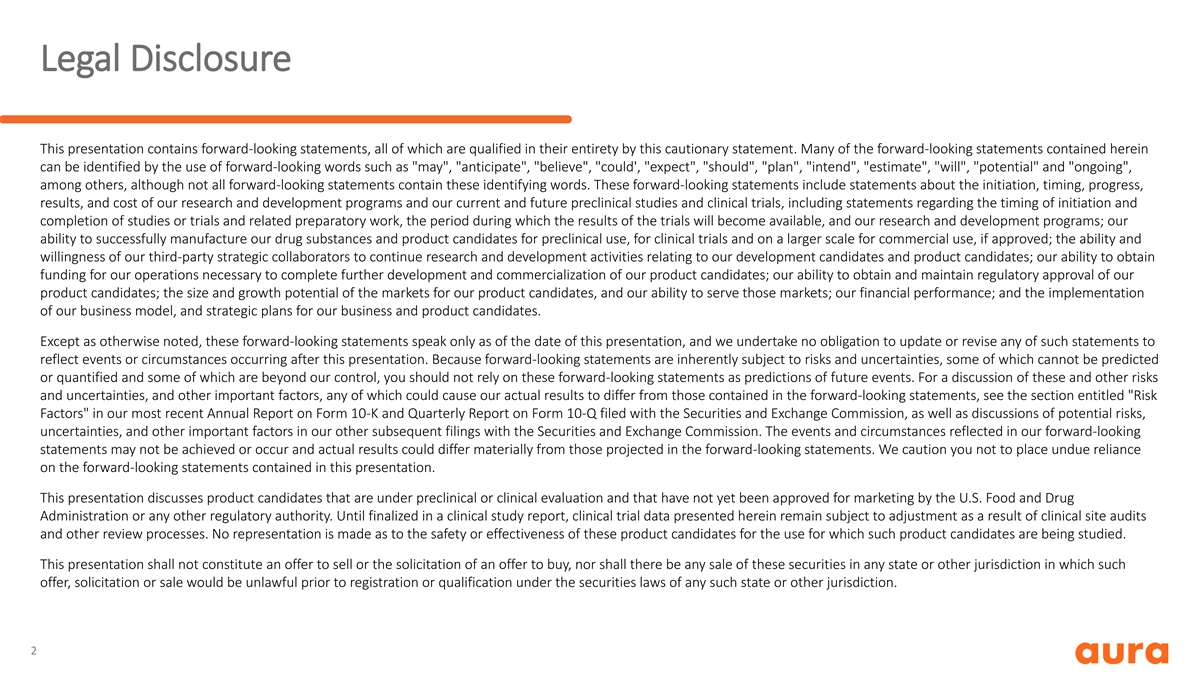
Legal Disclosure This presentation contains forward-looking statements,
all of which are qualified in their entirety by this cautionary statement. Many of the forward-looking statements contained herein can be identified by the use of forward-looking words such as may , anticipate , believe , could', expect , should ,
plan , intend , estimate , will , potential and ongoing , among others, although not all forward-looking statements contain these identifying words. These forward-looking statements include statements about the initiation, timing, progress, results,
and cost of our research and development programs and our current and future preclinical studies and clinical trials, including statements regarding the timing of initiation and completion of studies or trials and related preparatory work, the
period during which the results of the trials will become available, and our research and development programs; our ability to successfully manufacture our drug substances and product candidates for preclinical use, for clinical trials and on a
larger scale for commercial use, if approved; the ability and willingness of our third-party strategic collaborators to continue research and development activities relating to our development candidates and product candidates; our ability to obtain
funding for our operations necessary to complete further development and commercialization of our product candidates; our ability to obtain and maintain regulatory approval of our product candidates; the size and growth potential of the markets for
our product candidates, and our ability to serve those markets; our financial performance; and the implementation of our business model, and strategic plans for our business and product candidates. Except as otherwise noted, these forward-looking
statements speak only as of the date of this presentation, and we undertake no obligation to update or revise any of such statements to reflect events or circumstances occurring after this presentation. Because forward-looking statements are
inherently subject to risks and uncertainties, some of which cannot be predicted or quantified and some of which are beyond our control, you should not rely on these forward-looking statements as predictions of future events. For a discussion of
these and other risks and uncertainties, and other important factors, any of which could cause our actual results to differ from those contained in the forward-looking statements, see the section entitled Risk Factors in our most recent Annual
Report on Form 10-K and Quarterly Report on Form 10-Q filed with the Securities and Exchange Commission, as well as discussions of potential risks, uncertainties, and other important factors in our other subsequent filings with the Securities and
Exchange Commission. The events and circumstances reflected in our forward-looking statements may not be achieved or occur and actual results could differ materially from those projected in the forward-looking statements. We caution you not to place
undue reliance on the forward-looking statements contained in this presentation. This presentation discusses product candidates that are under preclinical or clinical evaluation and that have not yet been approved for marketing by the U.S. Food and
Drug Administration or any other regulatory authority. Until finalized in a clinical study report, clinical trial data presented herein remain subject to adjustment as a result of clinical site audits and other review processes. No representation is
made as to the safety or effectiveness of these product candidates for the use for which such product candidates are being studied. This presentation shall not constitute an offer to sell or the solicitation of an offer to buy, nor shall there be
any sale of these securities in any state or other jurisdiction in which such offer, solicitation or sale would be unlawful prior to registration or qualification under the securities laws of any such state or other jurisdiction. 2
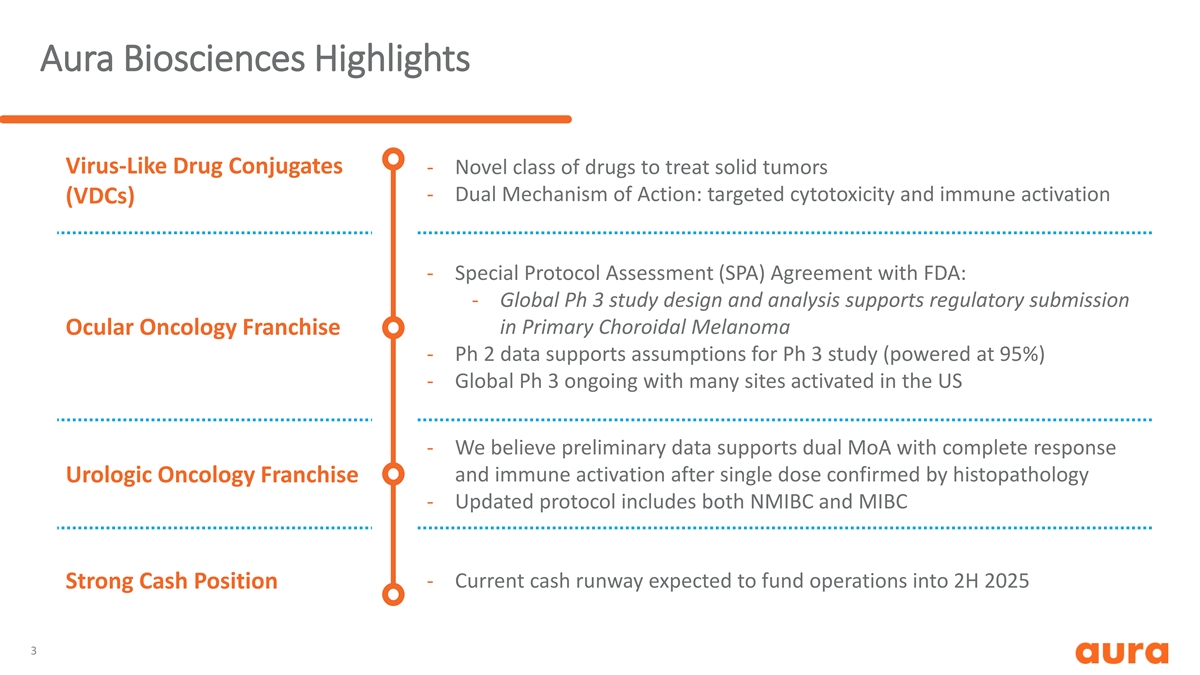
Aura Biosciences Highlights Virus-Like Drug Conjugates - Novel class of
drugs to treat solid tumors - Dual Mechanism of Action: targeted cytotoxicity and immune activation (VDCs) - Special Protocol Assessment (SPA) Agreement with FDA: - Global Ph 3 study design and analysis supports regulatory submission in Primary
Choroidal Melanoma Ocular Oncology Franchise - Ph 2 data supports assumptions for Ph 3 study (powered at 95%) - Global Ph 3 ongoing with many sites activated in the US - We believe preliminary data supports dual MoA with complete response and immune
activation after single dose confirmed by histopathology Urologic Oncology Franchise - Updated protocol includes both NMIBC and MIBC - Current cash runway expected to fund operations into 2H 2025 Strong Cash Position 3
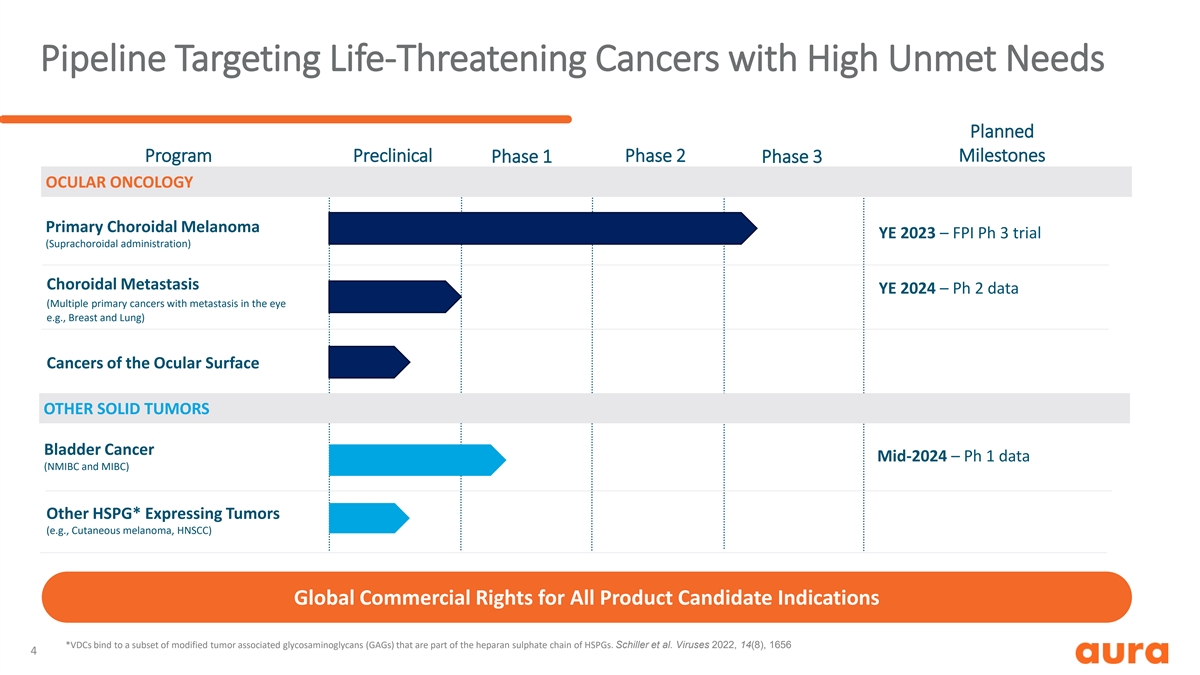
Pipeline Targeting Life-Threatening Cancers with High Unmet Needs
Planned Milestones Program Preclinical Phase 1 Phase 2 Phase 3 OCULAR ONCOLOGY Primary Choroidal Melanoma YE 2023 – FPI Ph 3 trial (Suprachoroidal administration) Choroidal Metastasis YE 2024 – Ph 2 data (Multiple primary cancers with
metastasis in the eye e.g., Breast and Lung) Cancers of the Ocular Surface OTHER SOLID TUMORS Bladder Cancer Mid-2024 – Ph 1 data (NMIBC and MIBC) Other HSPG* Expressing Tumors (e.g., Cutaneous melanoma, HNSCC) Global Commercial Rights for All
Product Candidate Indications *VDCs bind to a subset of modified tumor associated glycosaminoglycans (GAGs) that are part of the heparan sulphate chain of HSPGs. Schiller et al. Viruses 2022, 14(8), 1656 4

Targeted Oncology Platform: Virus-Like Drug Conjugates (VDCs) Potential
Treatment of Virus-Like Particle Conjugated Selective Binding to Tumor Associated HSPGs* to a Cytotoxic Payload Multiple Solid Tumors Cx Virus-Like Drug Virus-Like Particle Cytotoxic Drug Conjugate (VDC) (VLP) Potential Key Differentiation: Potency,
Multivalent Binding and Selectivity Kines et al; International Journal of Cancer, 138;901–911, February 2016; Kines et al; Molecular Cancer Therapeutics, 17(2) February 2018; Kines et al; Cancer Immunology Research, May 2021 5 *VDCs bind to a
subset of modified tumor associated glycosaminoglycans (GAGs) that are part of the heparan sulphate chain of HSPGs. Schiller et al. Viruses 2022, 14(8), 1656
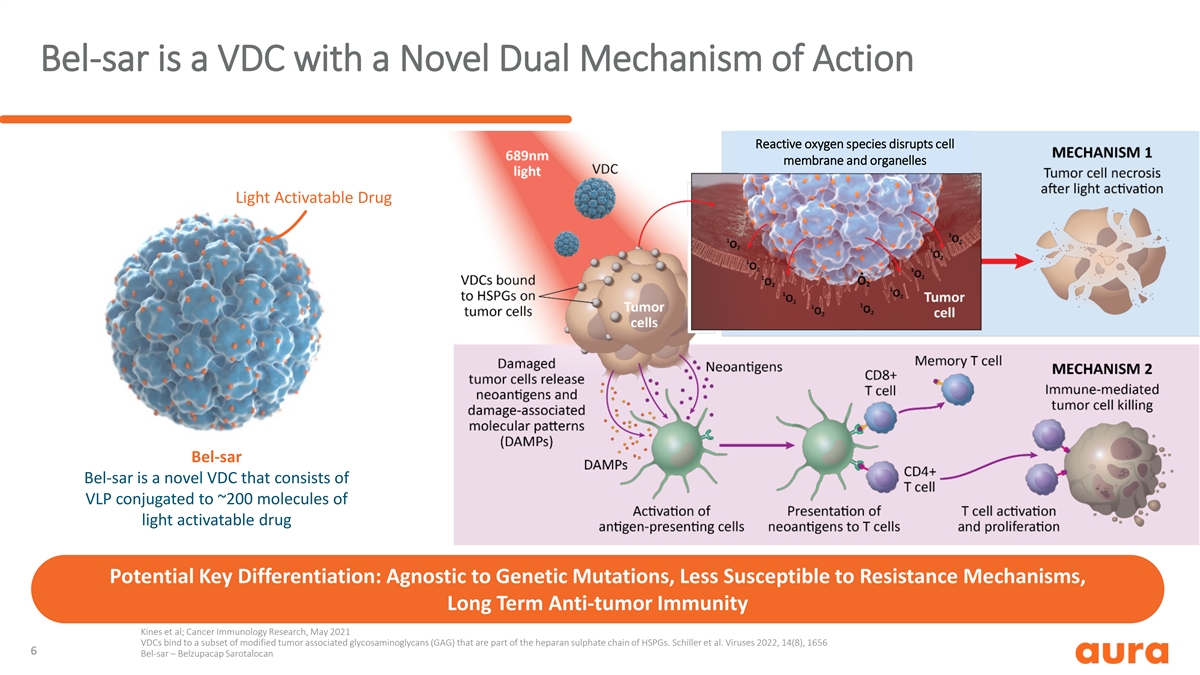
Bel-sar is a VDC with a Novel Dual Mechanism of Action Reactive oxygen
species disrupts cell membrane and organelles Light Activatable Drug Bel-sar Bel-sar is a novel VDC that consists of VLP conjugated to ~200 molecules of light activatable drug Potential Key Differentiation: Agnostic to Genetic Mutations, Less
Susceptible to Resistance Mechanisms, Long Term Anti-tumor Immunity Kines et al; Cancer Immunology Research, May 2021 VDCs bind to a subset of modified tumor associated glycosaminoglycans (GAG) that are part of the heparan sulphate chain of HSPGs.
Schiller et al. Viruses 2022, 14(8), 1656 6 Bel-sar – Belzupacap Sarotalocan

Ocular Oncology Bel-sar Franchise INN: belzupacap sarotalocan Target
Indications: • Early-Stage Choroidal Melanoma • Choroidal Metastasis • Other Ocular Cancers 7
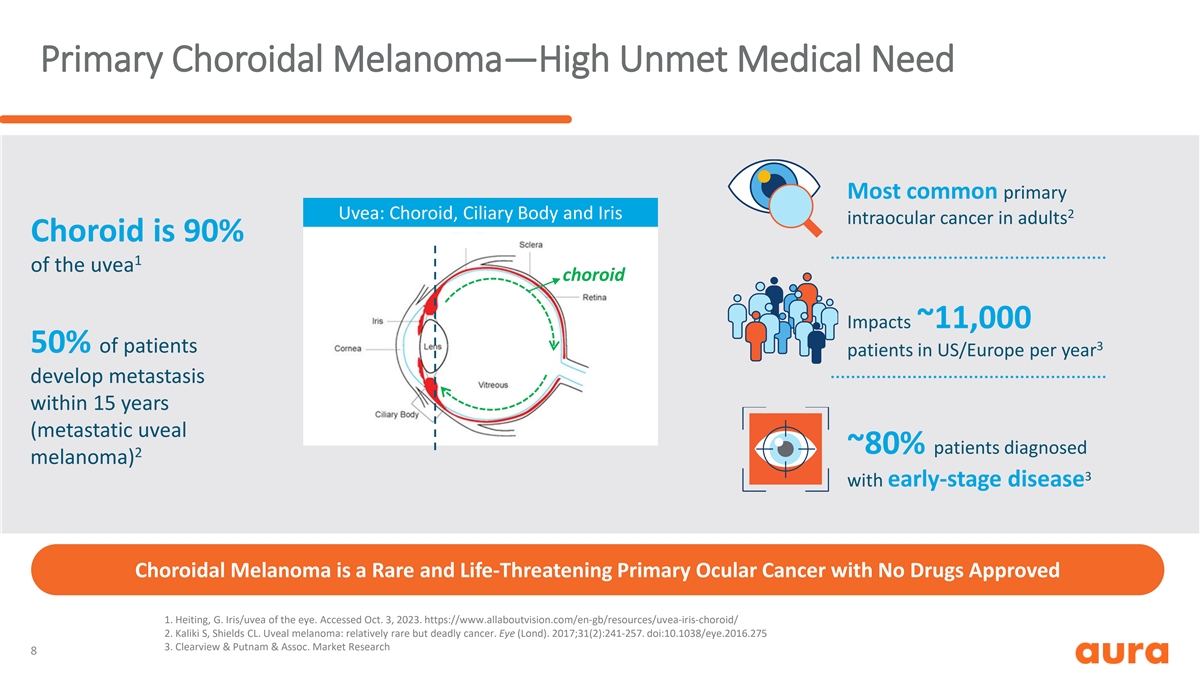
Primary Choroidal Melanoma—High Unmet Medical Need Most common
primary Uvea: Choroid, Ciliary Body and Iris 2 intraocular cancer in adults Choroid is 90% 1 of the uvea choroid Impacts ~11,000 3 50% of patients patients in US/Europe per year develop metastasis within 15 years (metastatic uveal ~80% patients
diagnosed 2 melanoma) 3 with early-stage disease Choroidal Melanoma is a Rare and Life-Threatening Primary Ocular Cancer with No Drugs Approved 1. Heiting, G. Iris/uvea of the eye. Accessed Oct. 3, 2023.
https://www.allaboutvision.com/en-gb/resources/uvea-iris-choroid/ 2. Kaliki S, Shields CL. Uveal melanoma: relatively rare but deadly cancer. Eye (Lond). 2017;31(2):241-257. doi:10.1038/eye.2016.275 3. Clearview & Putnam & Assoc. Market
Research 8

Radiotherapy is the Standard of Care for Early-Stage Disease Plaque
Brachytherapy for Choroidal Melanoma Requires Invasive Surgery with Irreversible Complications and Does Not Prevent Metastasis 2 (A) Schematic drawing showing a Collaborative Ocular Melanoma Study (COMS) style plaque Surgical treatment of large
choroidal melanoma with ruthenium 106 plaque brachytherapy 1 sutured to the sclera overlying the location of the uveal melanoma (B) Intraoperative photograph showing COMS plaque in place. The plaque stays in place for 3 1 to 7 days Maculopathy,
Cataract, Glaucoma, Vitreous Detachment and Vitreous Hemorrhage 3 are Common Vision Threatening Complications of Brachytherapy 1. Up To Date. Plaque brachytherapy for uveal melanoma. Accessed September 20, 2023.
https://ykhoa.org/d/image.htm?imageKey=ONC/116591 2. Kim M, Lee SM, Lee. Surgical treatment of a large choroidal melanoma. American Academy of Optometry 2022 Video Program. March 1, 2023. Accessed September 20, 2023.
https://www.aao.org/education/annual-meeting-video/surgical-treatment-of-large-choroidal-melanoma 9 3. Peddada KV, Sangani R, Menon H, Verma V. Complications and adverse events of plaque brachytherapy for ocular melanoma. J Contemp Brachytherapy.
2019;11(4):392-397. doi:10.5114/jcb.2019.87407

Up to 87% of Patients Will be Blinded when Treated with Radiotherapy
Contrast Sensitivity Diminishes Significantly within Proportion of Patients Legally Blind (BCVA the First Year after Brachytherapy and Continues to Proportion of patients legally blin 1, d 2 (BCVA ≤20/200) after Brachytherapy 2 Deteriorate
Over Time 1, 2 ≤20/200) after Brachy Therapy 100% 80% 60% 40% 20% 0% Baseline Year 1 Year 2 Year 3 Long Term Vision with Reduced Normal Vision Contrast Sensitivity Visual Acuity, Color Vision and Contrast Sensitivity Decrease Significantly
within the First Year after Treatment and Continue to Decrease Over Time 1. Jarczak J, Karska-Basta I, Romanowska-Dixon B. Deterioration of visual acuity after brachytherapy and proton therapy of uveal melanoma, and methods of counteracting this
complication based on recent publications. Medicina (Kaunas). 2023;59(6):1131. 2. Tsui I, Beardsley RM, McCannel TA, Oliver SC, et al. Visual acuity, contrast sensitivity and color vision three years after iodine-125 brachytherapy for choroidal and
ciliary body melanoma. Open Ophthalmol J. 2015;9:131-5. 10

Benefit/Risk of Radiotherapy Drives “Watch and Wait” in
Patients with Early-Stage Disease Early Stage Late Stage Metastatic Disease 2 Indeterminate Lesions and Small PCM Medium/large PCM (~2,000) 1 1 (~8,000) (~2,300) Watch and Wait/Brachytherapy Systemic Chemotherapy Brachytherapy: Vision Loss/Blindness
(KIMMTRAK) inevitably Most of the Addressable Population is Untreated Due to Risk of Treatment Related Vision Loss and Severe Comorbidities 1. Clearview & Putnam & Assoc. Market Research 11 2. Kaliki S, Shields CL. Uveal melanoma: relatively
rare but deadly cancer. Eye (Lond). 2017;31(2):241-257. doi:10.1038/eye.2016.275 Current Prevalence: Treatment Patients US/EU
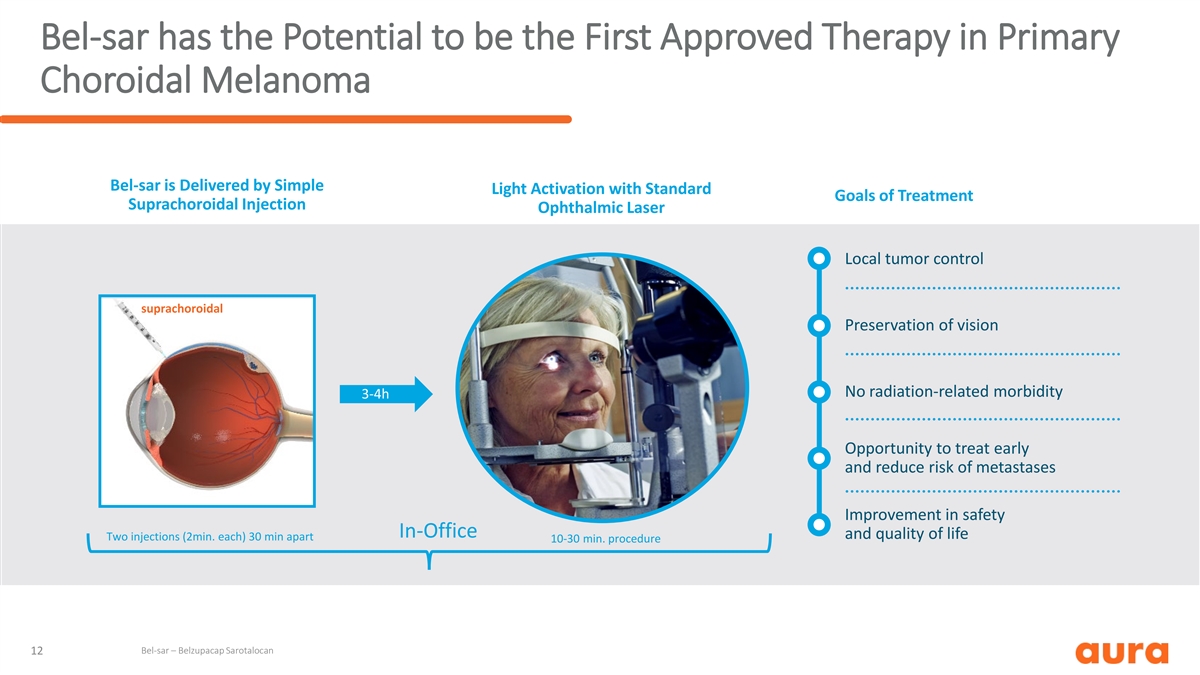
Bel-sar has the Potential to be the First Approved Therapy in Primary
Choroidal Melanoma Bel-sar is Delivered by Simple Light Activation with Standard Goals of Treatment Suprachoroidal Injection Ophthalmic Laser Local tumor control suprachoroidal Preservation of vision No radiation-related morbidity 3-4h Opportunity
to treat early and reduce risk of metastases Improvement in safety In-Office and quality of life Two injections (2min. each) 30 min apart 10-30 min. procedure Bel-sar – Belzupacap Sarotalocan 12

Ocular Oncology Franchise Represents a Multi-Billion Dollar Addressable
Market Opportunity ~66,000 patients/year 11,000 patients/year Ocular Oncology Franchise total addressable market (US/EU) Choroidal Melanoma patients diagnosed each year (US/EU) 3 1 ~35,000 patients/year 11,000 patients/year Current radiotherapy ~80%
Cancers of the Ocular Surface Choroidal Melanoma treatment of patients are diagnosed Leaves ~87% of patients with at the early stage Multibillion $ major irreversible vision loss (indeterminate lesions addressable (ILs) and small tumors) market
opportunity <20 ~100 Choroidal Metastasis Field Based Team Ocular Oncologists in Retinoblastoma Intend to add small US/EU — focused call 1 2 20,000 patients/year sales force 500 patients/year point to launch globally 1. ClearView &
Putnam & Assoc. Epidemiology Analysis Choroidal Melanoma and Choroidal Metastasis 2. American Cancer Society- Retinoblastoma statistics 3. Includes Conjunctival Melanoma, Primary Acquired Melanosis, Squamous Cell Carcinoma and Ocular Surface
Squamous Neoplasia 13 (https://pubmed.ncbi.nlm.nih.gov/12788119/; https://pubmed.ncbi.nlm.nih.gov/19628487/; https://pubmed.ncbi.nlm.nih.gov/8676629/; https://pubmed.ncbi.nlm.nih.gov/29511061/; https://pubmed.ncbi.nlm.nih.gov/9037556/)
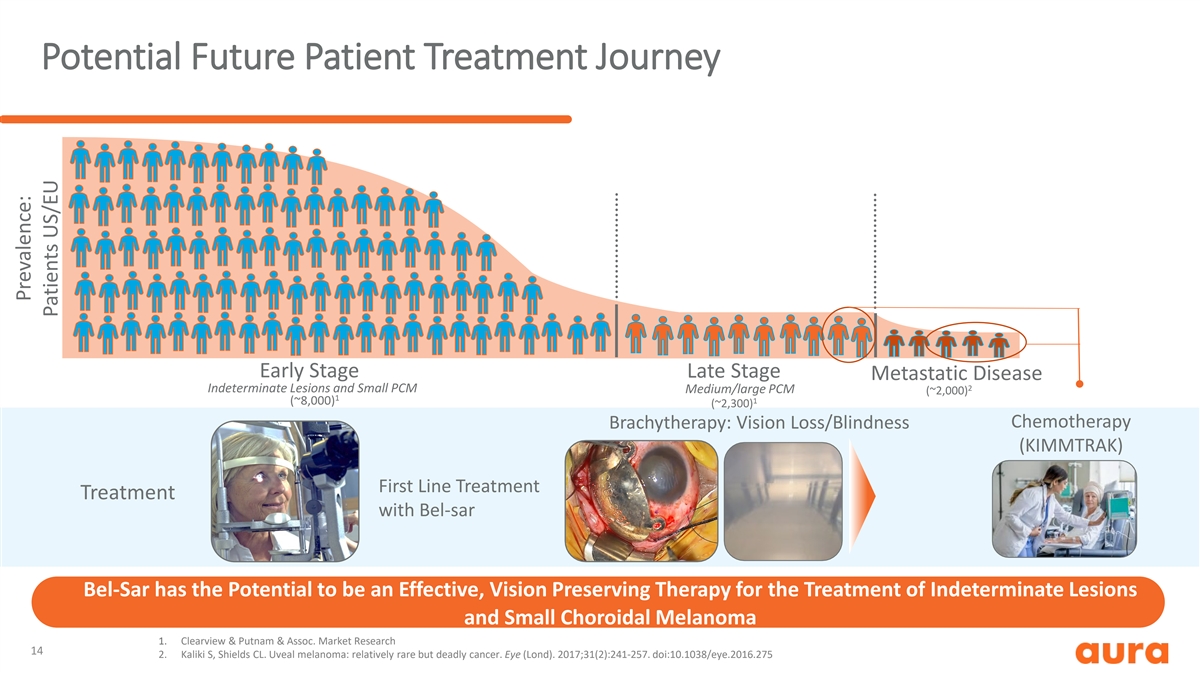
Potential Future Patient Treatment Journey Early Stage Late Stage
Metastatic Disease 2 Indeterminate Lesions and Small PCM Medium/large PCM (~2,000) 1 1 (~8,000) (~2,300) Chemotherapy Brachytherapy: Vision Loss/Blindness (KIMMTRAK) First Line Treatment Treatment with Bel-sar Bel-Sar has the Potential to be an
Effective, Vision Preserving Therapy for the Treatment of Indeterminate Lesions and Small Choroidal Melanoma 1. Clearview & Putnam & Assoc. Market Research 14 2. Kaliki S, Shields CL. Uveal melanoma: relatively rare but deadly cancer. Eye
(Lond). 2017;31(2):241-257. doi:10.1038/eye.2016.275 Prevalence: Patients US/EU

Bel-sar has Demonstrated a Favorable Profile for the Treatment of
Early-Stage Disease Darovasertib + Crizotinib 1 KIMMTRAK Bel-Sar 2 Combination Adverse Event or Adverse Reactions Any Grade Any Grade Any Grade* Cytokine release syndrome 89% Not Disclosed 0% Rash 83% Not Disclosed 0% Pyrexia 76% Not Disclosed 0%
Pruritus 69% Not Disclosed 0% Fatigue 64% 40% 0% Nausea 49% 79% 0% Vomiting Not Disclosed 52% 0% Chills 48% Not Disclosed 0% Hypo-/hyperpigmentation 47% Not Disclosed 0% Abdominal pain 45% Not Disclosed 0% Edema 45% 57% 0% dermatitis acneiform Not
Disclosed 44% 0% Hypotension Not Disclosed 34% 0% Hypoalbuminemia Not Disclosed 32% 0% Dizziness Not Disclosed 28% 0% 1. Immunocore Corporate Presentation. 2023 August. Slide 12.
https://ir.immunocore.com/static-files/415c5cbb-caae-4ffa-9beb-cb40cfcfc132 2. IDEAYA Clinical Update Presentation. 2023 April 24. Slide 10. Note: Certain data in this presentation are based on a cross-trial comparisons and are not based on any
head-to-head clinical trials. Cross-trial comparisons are inherently limited and may suggest misleading similarities or differences. Results of head-to-head comparisons may differ significantly from those set forth herein. 15 *Safety outcomes for
ongoing Ph2 study with bel-sar presented on slide 22

Choroidal Melanoma Ph 2 Data 16
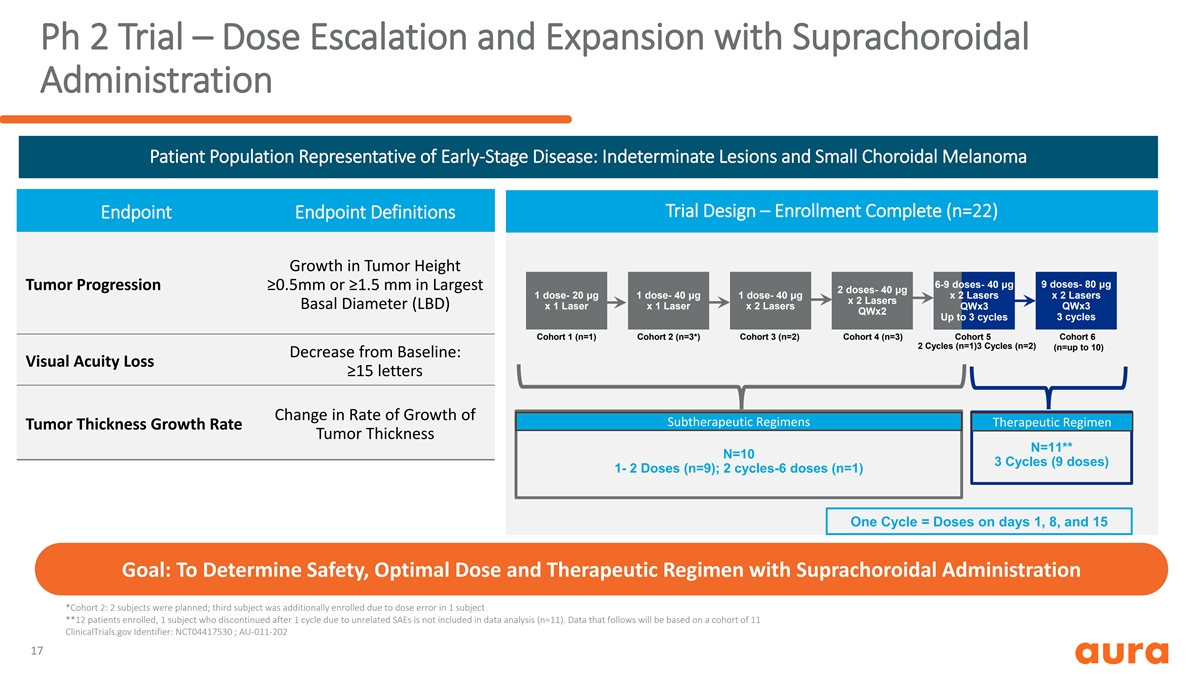
Ph 2 Trial – Dose Escalation and Expansion with Suprachoroidal
Administration Patient Population Representative of Early-Stage Disease: Indeterminate Lesions and Small Choroidal Melanoma Trial Design – Enrollment Complete (n=22) Endpoint Endpoint Definitions Growth in Tumor Height 9 doses- 80 μg 6-9
doses- 40 μg Tumor Progression ≥0.5mm or ≥1.5 mm in Largest 2 doses- 40 μg 1 dose- 20 μg 1 dose- 40 μg 1 dose- 40 μg x 2 Lasers x 2 Lasers x 2 Lasers Basal Diameter (LBD) x 1 Laser x 1 Laser x 2 Lasers QWx3 QWx3
QWx2 Up to 3 cycles 3 cycles Cohort 1 (n=1) Cohort 2 (n=3*) Cohort 3 (n=2) Cohort 4 (n=3) Cohort 5 Cohort 6 2 Cycles (n=1)3 Cycles (n=2) (n=up to 10) Decrease from Baseline: Visual Acuity Loss ≥15 letters Change in Rate of Growth of
Subtherapeutic Regimens Therapeutic Regimen Tumor Thickness Growth Rate Tumor Thickness N=11** N=10 3 Cycles (9 doses) 1- 2 Doses (n=9); 2 cycles-6 doses (n=1) One Cycle = Doses on days 1, 8, and 15 Goal: To Determine Safety, Optimal Dose and
Therapeutic Regimen with Suprachoroidal Administration *Cohort 2: 2 subjects were planned; third subject was additionally enrolled due to dose error in 1 subject **12 patients enrolled, 1 subject who discontinued after 1 cycle due to unrelated SAEs
is not included in data analysis (n=11). Data that follows will be based on a cohort of 11 ClinicalTrials.gov Identifier: NCT04417530 ; AU-011-202 17

High Tumor Control Rates Observed – Durable at 12 Months Follow
Up Dose Response: >90% Completed 12 Months Subtherapeutic vs Therapeutic Regimen Total Patients Tumor Control Dose/Regimen (n) Rate 100% Subtherapeutic Regimens 80% 80% Single dose up to 2 cycles 10 20% (2/10) 60% Therapeutic Regimen 3 Cycles
(n=11) 11 73% (8/11) 40% 3 Cycles and Ph 3 eligible (n=10)* 10 80% (8/10) 20% 20% * One subject with circumpapillary tumor that did not meet Ph 3 criteria is not included 0% Up to 2 Cycle Regimens (n=10) 3 Cycle Regimens (n=10) Tumor Progression:
change from baseline in thickness ≥0.5mm; or in LBD ≥1.5mm confirmed by at least one repeat assessment August 3, 2023, data on file Aura Biosciences High Tumor Control Rates with Therapeutic Regimen in Ph 3 Eligible Patients with Active
Growth 18 % Subjects with Tumor Control

High Tumor Control Rates Observed in Ph 3 Population Treated with
Therapeutic Regimen Subtherapeutic Regimens (n=10) Active Growth and 3 Cycle Regimens (n=10) Change from Baseline in Tumor Thickness Over 12 Months Change from Baseline in Tumor Thickness Over 12 Months 2.00 1.75 1.50 1.25 1.00 0.75 0.50 0.25 0.00
-0.25 -0.50 0 90 180 270 360 450 Treatment Treatment Follow-up Timeframe Follow-up Timeframe Timeframe Timeframe Patients who had documented growth at entry (n=6) Patients who had documented growth at entry (n=10) Patients who did not have
documented growth at entry (n=4) Progression Definition based on Tumor Thickness (Increase ≥0.5mm) Progression Definition based on Tumor Thickness (Increase ≥0.5mm) August 3, 2023, data on file Aura Biosciences Ph 2 Interim Data
Demonstrated Tumor Control Rate of 80%, with 90% of Patients at 12 Months of Follow Up 19 Change from Baseline in Tumor Thickness (mm) Change from Baseline in Tumor Thickness (mm)
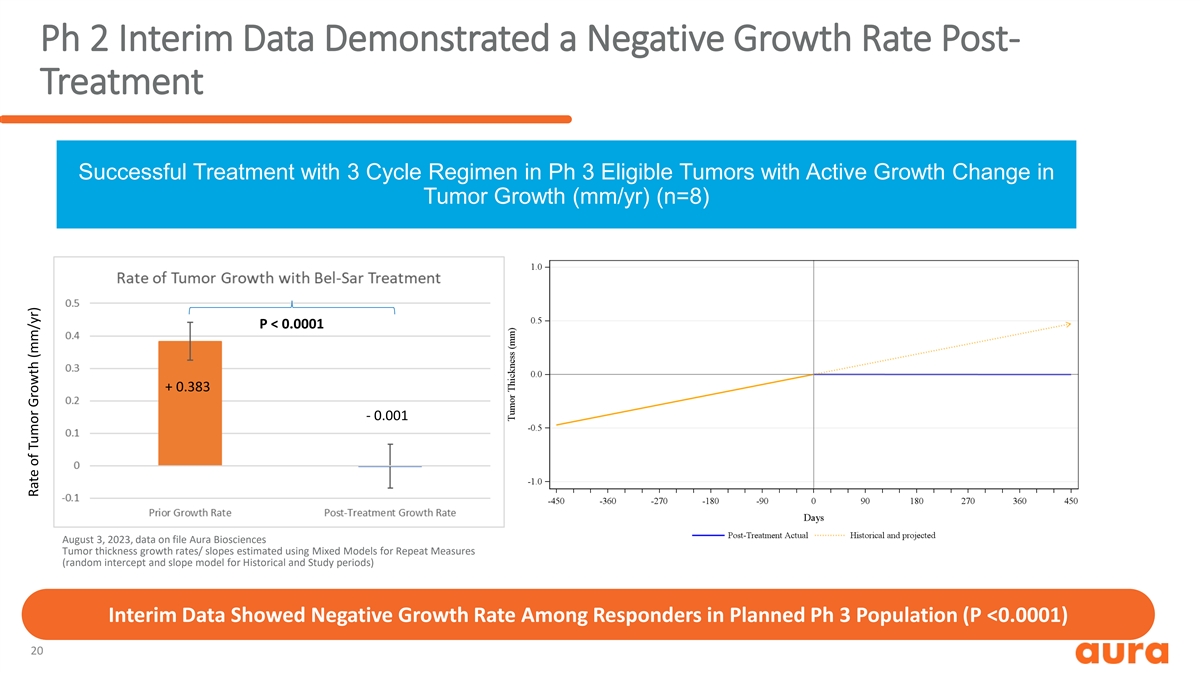
Ph 2 Interim Data Demonstrated a Negative Growth Rate Post- Treatment
Successful Treatment with 3 Cycle Regimen in Ph 3 Eligible Tumors with Active Growth Change in Tumor Growth (mm/yr) (n=8) P < 0.0001 + 0.383 - 0.001 August 3, 2023, data on file Aura Biosciences Tumor thickness growth rates/ slopes estimated
using Mixed Models for Repeat Measures (random intercept and slope model for Historical and Study periods) Interim Data Showed Negative Growth Rate Among Responders in Planned Ph 3 Population (P <0.0001) 20 Rate of Tumor Growth (mm/yr)

90% Visual Acuity Preservation Despite 80% of These Patients Being at
High Risk for Vision Loss >90% Patients Completed 12 months . Total Vision Vision Patients Failures Preservation Median Change in BCVA in Ph3 Eligible Populations (n) (n) Rate Patients with Therapeutic Regimen (n=10) All Dose Cohorts 3 1 All
Treated Patients 22 1 96% -1 Subtherapeutic -3 -5 Single dose up to 2 cycles 10 0 100% -7 Therapeutic Regimens -9 -11 3 Cycles (n=11) 11 1 91% -13 3 Cycles and Ph 3 eligible (n=10)* -15 10 1 90% 0 3 6 9 12 *One subject with circumpapillary tumor
that doesn’t meet Ph 3 criteria is not included Months Vision acuity loss definition based on ETDRS Vision Loss (15 letters) BCVA letter score (≥ 15 letters from baseline ) August 3, 2023, data on file Aura Biosciences 90% Visual Acuity
Preservation Data Supports Potential to be Front Line Therapy for Early-Stage Disease 21 Change from Baseline

Ph 2 Safety Data Supports Potential to be First Line Treatment in
Early-Stage Disease + Adverse Event Radiotherapy* Bel-Sar Ongoing Ph 2 Safety Outcomes with SC Administration + Surgeries secondary to AEs (e.g., Cataracts) 40%+ 0% All Treated Subjects (n=22) Radiation Retinopathy 40%+ 0% Grade III Total Drug/Laser
Related Adverse Events Grade I Grade II >5% Subjects* Neovascular Glaucoma 10% 0% Anterior Chamber Dry Eye Syndrome 20% 0% 18% 0 0 18% Inflammation Strabismus 2%+ 0% Anterior Chamber Cell 9% 0 0 9% Retinal Detachment 1-2% 0% Eye Pain 9% 0 0 9%
Vision Loss (≥15 letters) ~70% ~5% + Serious Adverse Event Radiotherapy* Bel-Sar Table presents percentage of subjects with AEs related to bel-sar or laser by severity and overall; subjects with more than 1 AE are counted in the highest
severity group *Treatment-emergent AEs related to bel-sar or laser in 1 patient each or <5% (anisocoria, conjunctival edema, Scleral Necrosis 0-5% 0% cystoid macular edema, pupillary reflex impaired, retinal pigment epitheliopathy, salivary gland
enlargement) Enucleation/Eye Loss 10-15% 0% ++ Severe Vision Loss (≥30 letters) in HRVL** ~90% 0% August 3, 2023, data on file Aura Biosciences * Certain data in this presentation are based on a cross-trial comparisons and are not based on any
head-to-head clinical trials. Cross-trial comparisons are inherently limited and may suggest misleading similarities or differences. Results of head-to-head comparisons may differ significantly from those set forth herein. +Related to bel-sar or
laser **73% (16/22) of patients in Ph2 SC trial were at high risk for vision loss No Posterior Inflammation, No SAEs and No Grade 3 Related Adverse Events *J. Contemp Brachytherapy. J. 2019 Aug; 11(4): 392–397.; Arch Ophthalmol.
2000;118(9):1219-1228; Curr. Opin. Ophthalmol. 2019 May;30(3):206-214; Eye 2017 Feb;31(2):241-257 **High-Risk Vision Loss (HRVL) are those subjects with tumors <3mm to fovea or optic nerve 22 Bel-Sar – Belzupacap Sarotalocan; AEs –
Adverse Events; SAEs – Serious Adverse Events
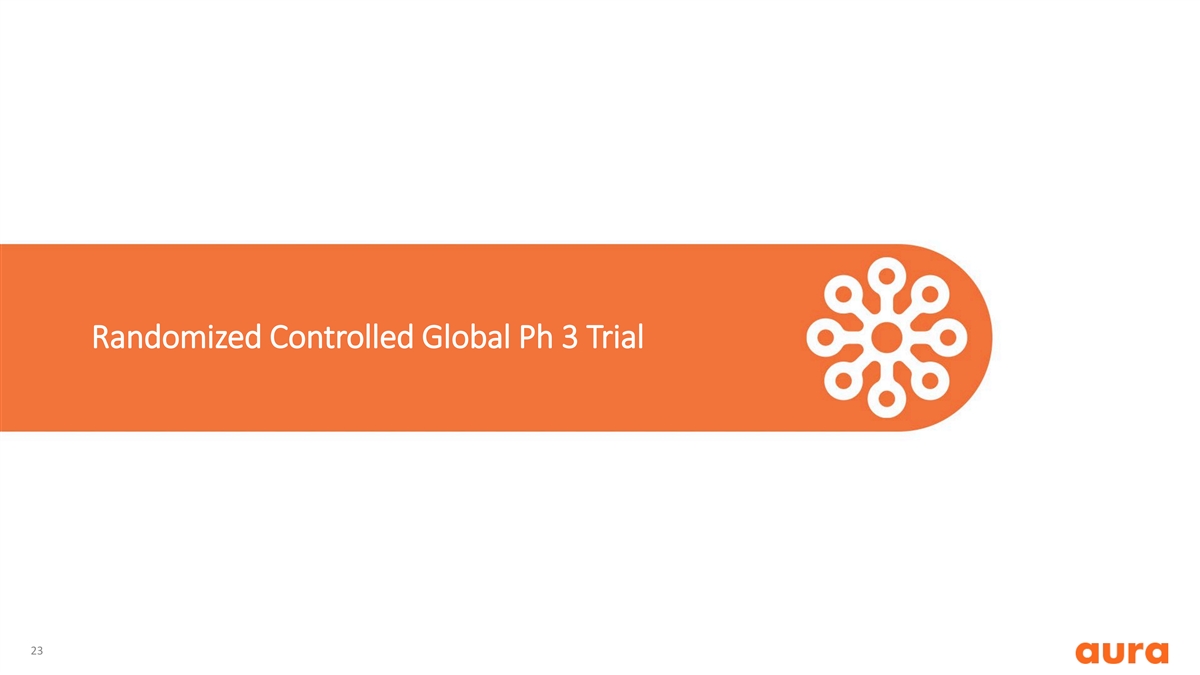
Randomized Controlled Global Ph 3 Trial 23
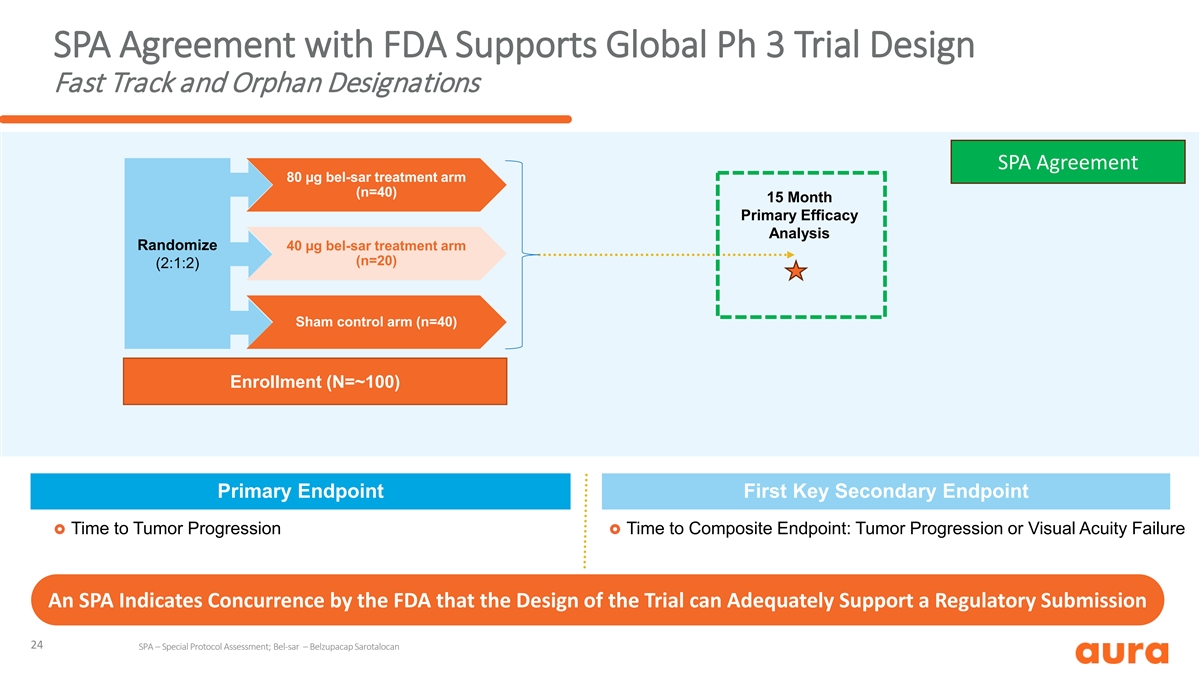
SPA Agreement with FDA Supports Global Ph 3 Trial Design Fast Track and
Orphan Designations SPA Agreement 80 µg bel-sar treatment arm (n=40) 15 Month Primary Efficacy Analysis Randomize 40 µg bel-sar treatment arm (n=20) (2:1:2) Sham control arm (n=40) Enrollment (N=~100) Primary Endpoint First Key Secondary
Endpoint £ Time to Tumor Progression£ Time to Composite Endpoint: Tumor Progression or Visual Acuity Failure An SPA Indicates Concurrence by the FDA that the Design of the Trial can Adequately Support a Regulatory Submission 24 SPA –
Special Protocol Assessment; Bel-sar – Belzupacap Sarotalocan
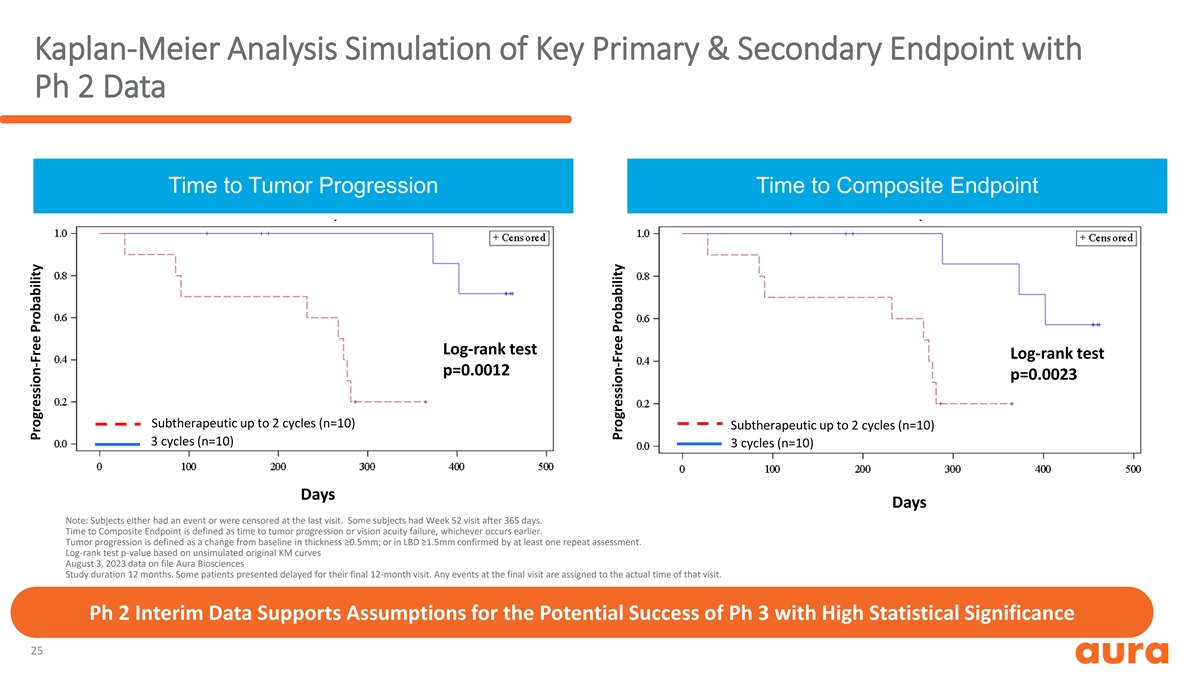
Kaplan-Meier Analysis Simulation of Key Primary & Secondary
Endpoint with Ph 2 Data Time to Tumor Progression Time to Composite Endpoint Log-rank test Log-rank test p=0.0012 p=0.0023 Subtherapeutic up to 2 cycles (n=10) Subtherapeutic up to 2 cycles (n=10) 3 cycles (n=10) 3 cycles (n=10) Days Days Note:
Subjects either had an event or were censored at the last visit. Some subjects had Week 52 visit after 365 days. Time to Composite Endpoint is defined as time to tumor progression or vision acuity failure, whichever occurs earlier. Tumor progression
is defined as a change from baseline in thickness ≥0.5mm; or in LBD ≥1.5mm confirmed by at least one repeatassessment. Log-rank test p-value based on unsimulated original KM curves August 3, 2023 data on file Aura Biosciences Study
duration 12 months. Some patients presented delayed for their final 12-month visit. Any events at the final visit are assigned to the actual time of that visit. Ph 2 Interim Data Supports Assumptions for the Potential Success of Ph 3 with High
Statistical Significance 25 Progression-Free Probability Progression-Free Probability

Clinical Endpoints to Support Potential Approval in Alignment with
Regulatory Agencies Endpoint Endpoint Assumptions Endpoint Definitions Bel-sar: 35% Tumor Progression Growth in Tumor Height ≥0.5mm or Tumor Progression Sham: 80% Tumor Progression ≥1.5 mm in Largest Basal Diameter Bel-sar: 15% VA Loss
Decrease from baseline: Vision Acuity Loss Sham: 2% VA Loss ≥15 letters Tumor Progression Assumptions Visual Acuity Loss Assumptions 80% 13% 45% 15% 35% 2% Sham Bel-sar Sham Bel-sar Conservative Assumptions Provide Support for Potential for
Regulatory Submission (Phase 3 Trial Powered at 95%) Note: Tumor Height is synonymous with Tumor Thickness; VA – Visual Acuity; Bel-sar – Belzupacap Sarotalocan 26 Composite Endpoint

Choroidal Metastasis 27

Choroidal Metastasis is a High Unmet Medical Need Standard of Care is
Daily Radiotherapy Originate from Multiple for 4 Weeks Primary Cancers Breast Skin (e.g., Breast and Lung) 40-53% 2% 20,000/year eyes Lung diagnosed in US Kidney 20-29% 2% 88% with choroidal location GI Prostate 72% unilateral and solitary 4% Vision
Loss and Radiation Associated 2% Complications Choroidal Metastasis Cause Decreased Vision and Decreased Quality of Life in Patients Fighting Metastatic Cancer Mathis et al. New concepts in choroidal metastasis, Progress in retinal and eye research
(2019), Cohen, Ocular metastasis, Eye (2014), Shields et al. Survey of 520 eyes with uveal 28 metastases. Ophthalmology (1997), Namad et al. Bilateral choroidal metastasis from non-small lung cancer, Case reports in oncological medicine (2014).

Choroidal Metastasis – Ph 2 Trial Design Study Design (n=12*)
Cohort 1a Cohort 2a Cohort 3a Cohort 3b N=3 patients N=3 patients N=3 patients N=3 patients 80µg x 2L 140µg x 2L 200µg x 2L 200µg x 2L 1 cycle 1 cycle 1 cycle 2 cycles Study Objectives Study Population • Safety/DLT •
Patients with unilateral, unifocal choroidal metastasis • Efficacy • Breast or Lung Primary • Choroidal Tumor Progression • No changes in concurrent systemic • Choroidal Tumor Growth rate medications planned •
Vision improvement Highlights: Primary Endpoint at one-month post-treatment; possibility to see tumor shrinkage; FDA oncology division 29 *3+3 Design. Each cohort will have a minimum of 3 and a maximum of 6 patients.
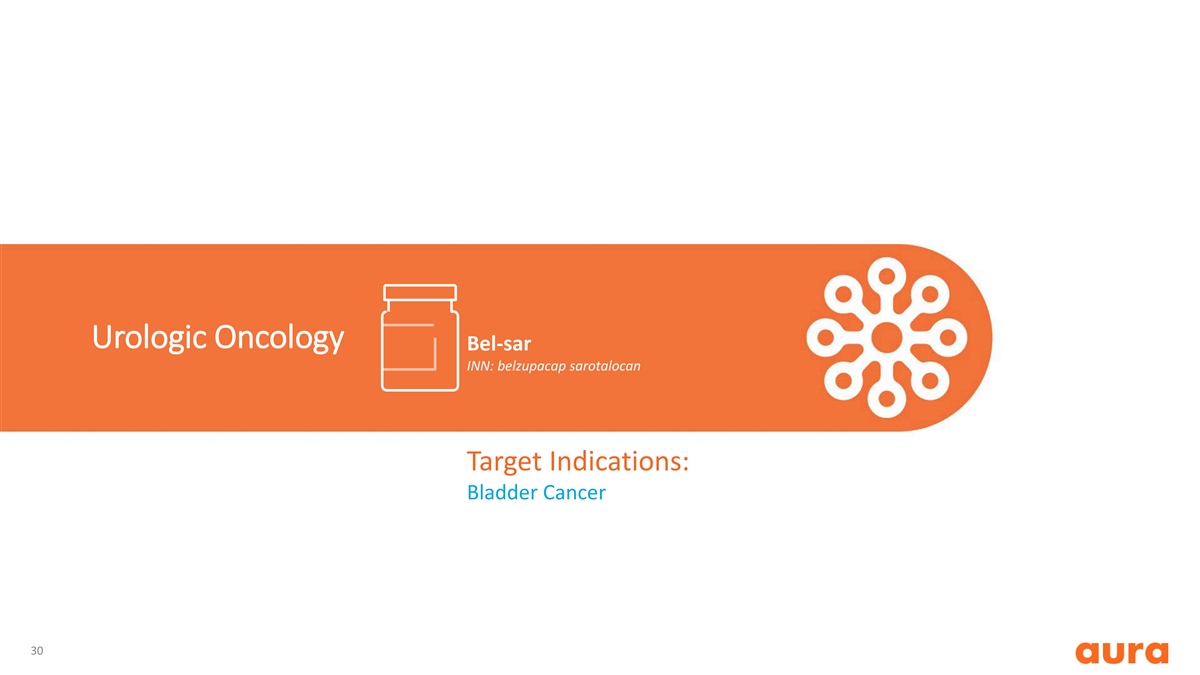
Urologic Oncology Bel-sar INN: belzupacap sarotalocan Target
Indications: Bladder Cancer 30

Bladder Cancer is a High Unmet Medical Need 61,000 20,000 ~500,000 1 1
2 New cases/year in the US New cases/year in the US New cases/ year globally Muscle Invasive Bladder Cancer Non-Muscle Invasive Bladder Cancer Unmet Need Unmet Need Recurrence, multiple TURBT surgeries, Progression of Disease, Loss of
Bladder/Cystectomy, Progression of Disease, Loss of Metastasis and Survival Bladder/Cystectomy 31 1. Putnam & Assoc. Epidemiology Analysis 2. Campbell-Walsh-wein Urology, 2021, 12th edition ; Chapter 137, page 3112

Bel-Sar has the Potential to be Front Line in Conjunction with TURBT
Adjuvant Urologist Therapy Intravesical Presents with Diagnosis and Cystectomy BCG Refractory BCG >6 tx TURBT gene therapy Blood in urine Treatment Plan (Adstiladrin) Systemic INTRAVESICAL recurrence Immunotherapy CHEMOTHERAPY (Keytruda) Adjuvant
Urologist Therapy Bel-sar Intravesical Presents with + Diagnosis and gene therapy Cystectomy BCG >6 tx BCG Refractory (Adstiladrin) Blood in urine Treatment Plan TURBT Systemic Immunotherapy INTRAVESICAL (Keytruda) CHEMOTHERAPY Adding Bel-sar can
potentially: • Prevent Recurrence after TURBT • Avoid need for Adjuvant Chemotherapy • Avoid need for six cycles of BCG • Increase efficacy of checkpoint inhibitors BCG – Bacillus Calmette Guerin; • Prevent
Cystectomy 32 TURBT- transurethral resection of bladder tumor Illustrative Current Illustrative Future Bladder Cancer Bladder Cancer Patient Journey Patient Journey
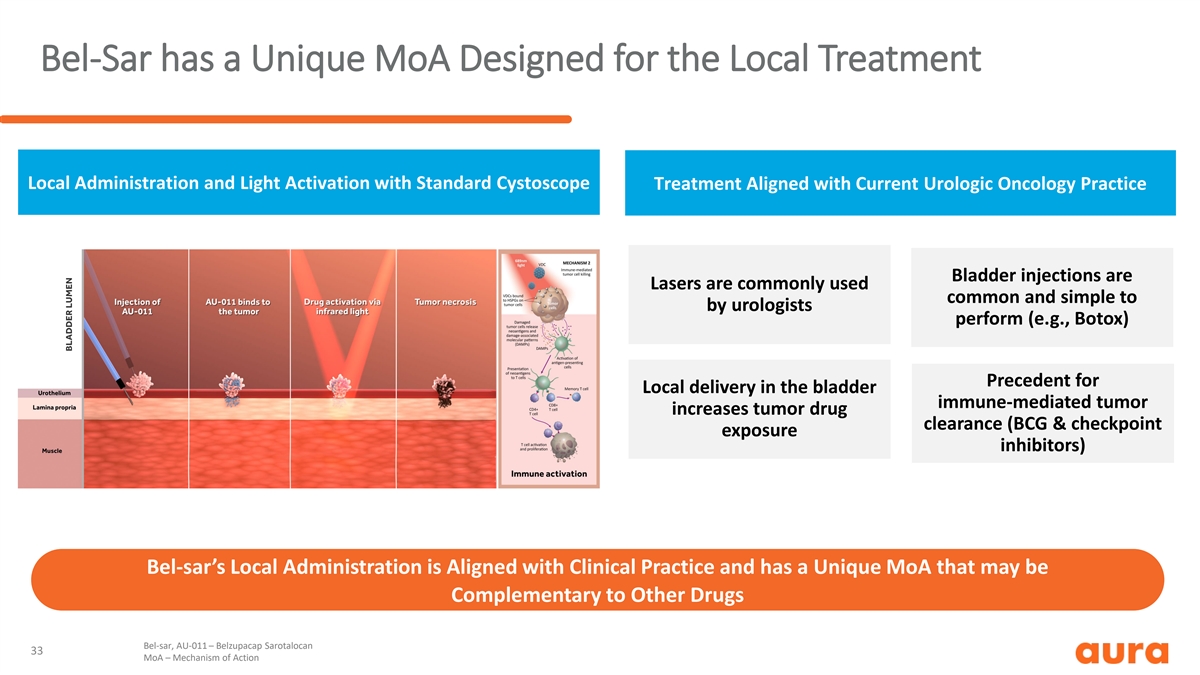
Bel-Sar has a Unique MoA Designed for the Local Treatment Local
Administration and Light Activation with Standard Cystoscope Treatment Aligned with Current Urologic Oncology Practice Bladder injections are Lasers are commonly used common and simple to by urologists perform (e.g., Botox) Precedent for Local
delivery in the bladder immune-mediated tumor increases tumor drug clearance (BCG & checkpoint exposure inhibitors) Bel-sar’s Local Administration is Aligned with Clinical Practice and has a Unique MoA that may be Complementary to Other
Drugs Bel-sar, AU-011 – Belzupacap Sarotalocan 33 MoA – Mechanism of Action

Ph 1 Trial Designed to Evaluate Safety, Feasibility and MoA Study
Objectives Study Design and Objectives (n=19) • Safety/DLT • Feasibility of technique Completed Part 1 (n=5) • Focal distribution of bel-sar No treatment-related Bel-sar Alone • Focal necrosis adverse events, serious adverse
events or dose- • Markers of immune activation limiting toxicities were seen for the 5 patients Study Population • TURBT and cystectomy patients Part 2 (n=14) Ongoing • NMIBC and MIBC patients Bel-sar + Focal Light Activation Ph 1
Data is Anticipated to Support the Future Development of Bel-sar for the Treatment of Both NMIBC and MIBC Bel-sar – Belzupacap Sarotalocan MoA – Mechanism of Action 34 TURBT- transurethral resection of bladder tumor
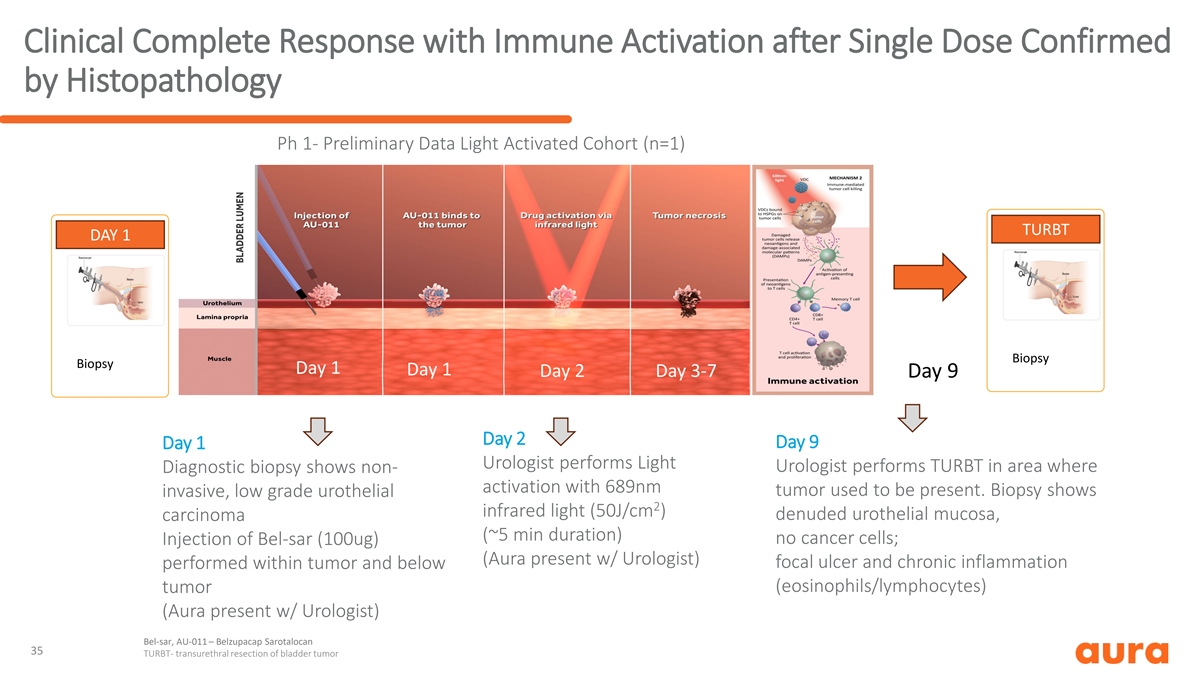
Clinical Complete Response with Immune Activation after Single Dose
Confirmed by Histopathology Ph 1- Preliminary Data Light Activated Cohort (n=1) TURBT DAY 1 Biopsy Biopsy Day 1 Day 1 Day 2 Day 3-7 Day 9 Day 2 Day 9 Day 1 Urologist performs Light Urologist performs TURBT in area where Diagnostic biopsy shows non-
activation with 689nm tumor used to be present. Biopsy shows invasive, low grade urothelial 2 infrared light (50J/cm ) denuded urothelial mucosa, carcinoma (~5 min duration) no cancer cells; Injection of Bel-sar (100ug) (Aura present w/ Urologist)
focal ulcer and chronic inflammation performed within tumor and below (eosinophils/lymphocytes) tumor (Aura present w/ Urologist) Bel-sar, AU-011 – Belzupacap Sarotalocan 35 TURBT- transurethral resection of bladder tumor

Pre-Treatment Biopsy (Day 1) shows Papillary Urothelial Carcinoma
H&E Stain Papillary urothelial carcinoma Example of papillary carcinoma (Ta) Pre-injection bladder biopsy demonstrating low-grade papillary urothelial carcinoma; non-invasive. 36

Clinical Complete Response Confirmed by Histopathology after Single
Dose of Bel-sar Disappearance of all cancer cells after treatment and immune activation Immune infiltrate necrosis Post-treatment TURBT demonstrating necrosis, inflammatory infiltrate, and no residual carcinoma. Circled region shows area of
necrosis; arrow indicates edge of inflammatory infiltrate. Evidence of Complete Response by Absence of Tumor Cells after Single Dose Treatment in First Patient 37
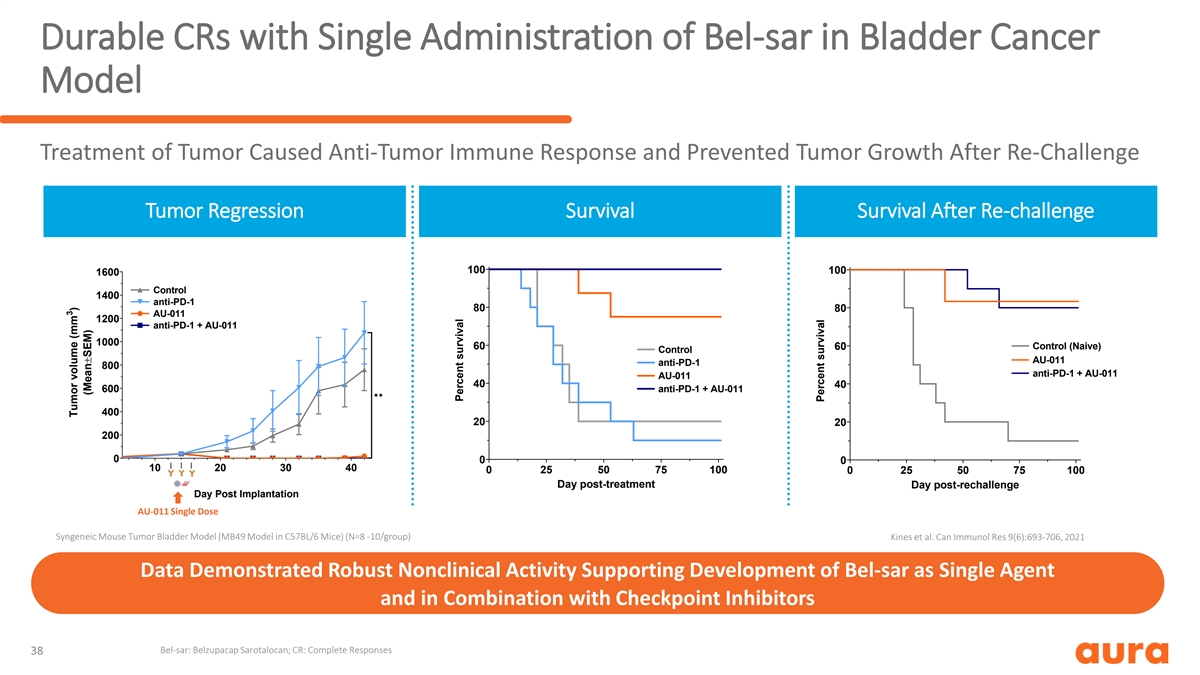
Durable CRs with Single Administration of Bel-sar in Bladder Cancer
Model Treatment of Tumor Caused Anti-Tumor Immune Response and Prevented Tumor Growth After Re-Challenge Tumor Regression Survival Survival After Re-challenge 100 100 1600 Control 1400 anti-PD-1 80 80 AU-011 1200 anti-PD-1 + AU-011 1000 60 60
Control (Naive) Control AU-011 anti-PD-1 800 anti-PD-1 + AU-011 AU-011 40 40 600 anti-PD-1 + AU-011 ✱✱ 400 20 20 200 0 0 0 10 20 30 40 0 25 50 75 100 0 25 50 75 100 Day post-treatment Day post-rechallenge Day Post Implantation AU-011
Single Dose Syngeneic Mouse Tumor Bladder Model (MB49 Model in C57BL/6 Mice) (N=8 -10/group) Kines et al. Can Immunol Res 9(6):693-706, 2021 Data Demonstrated Robust Nonclinical Activity Supporting Development of Bel-sar as Single Agent and in
Combination with Checkpoint Inhibitors Bel-sar: Belzupacap Sarotalocan; CR: Complete Responses 38 3 Tumor volume (mm ) (Mean±SEM) Percent survival Percent survival

Strategy & Key Milestones 39
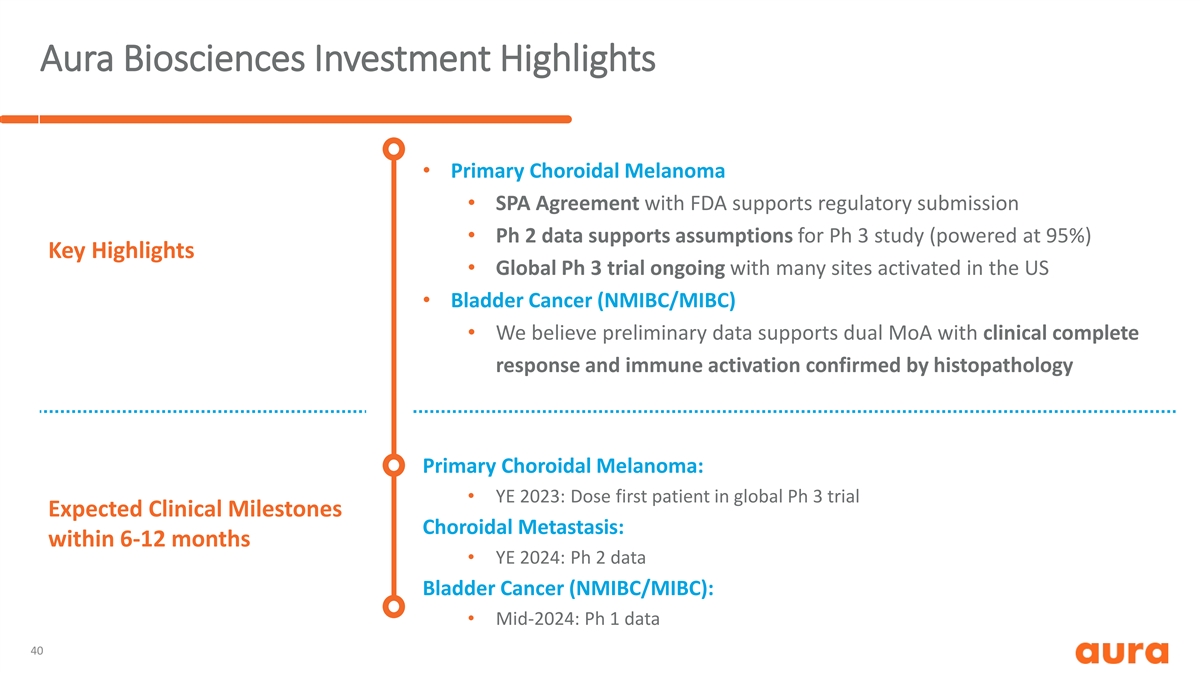
Aura Biosciences Investment Highlights • Primary Choroidal
Melanoma • SPA Agreement with FDA supports regulatory submission • Ph 2 data supports assumptions for Ph 3 study (powered at 95%) Key Highlights • Global Ph 3 trial ongoing with many sites activated in the US • Bladder Cancer
(NMIBC/MIBC) • We believe preliminary data supports dual MoA with clinical complete response and immune activation confirmed by histopathology Primary Choroidal Melanoma: • YE 2023: Dose first patient in global Ph 3 trial Expected
Clinical Milestones Choroidal Metastasis: within 6-12 months • YE 2024: Ph 2 data Bladder Cancer (NMIBC/MIBC): • Mid-2024: Ph 1 data 40


Bel-Sar Has Shown Long Term Durable Response with Visual Acuity
Preservation in Phase 3 Eligible Patient Base Line Characteristics Base Line Characteristics Phase 3 Eligible Subject Documented Tumor Growth Yes Tumor Size at Baseline AU-011 Treatment Cycles Tumor Height 1.03 mm Largest Basal Diameter (LBD) 6.12
mm Risk Factors Subretinal Fluid (F) Yes Orange Pigment (O) Yes Decreased Vision Caused by Tumor Yes Baseline Wk 4 Wk 6 Wk 12 Wk 16 Wk 30 Wk 39 Wk 52 Location Distance to Fovea 0 mm 0 mm BCVA 79 87 84 85 85 80 85 85 Distance to Optic Nerve (4 clock
hrs.) 42
v3.23.3
| X |
- DefinitionBoolean flag that is true when the XBRL content amends previously-filed or accepted submission.
| Name: |
dei_AmendmentFlag |
| Namespace Prefix: |
dei_ |
| Data Type: |
xbrli:booleanItemType |
| Balance Type: |
na |
| Period Type: |
duration |
|
| X |
- DefinitionFor the EDGAR submission types of Form 8-K: the date of the report, the date of the earliest event reported; for the EDGAR submission types of Form N-1A: the filing date; for all other submission types: the end of the reporting or transition period. The format of the date is YYYY-MM-DD.
| Name: |
dei_DocumentPeriodEndDate |
| Namespace Prefix: |
dei_ |
| Data Type: |
xbrli:dateItemType |
| Balance Type: |
na |
| Period Type: |
duration |
|
| X |
- DefinitionThe type of document being provided (such as 10-K, 10-Q, 485BPOS, etc). The document type is limited to the same value as the supporting SEC submission type, or the word 'Other'.
| Name: |
dei_DocumentType |
| Namespace Prefix: |
dei_ |
| Data Type: |
dei:submissionTypeItemType |
| Balance Type: |
na |
| Period Type: |
duration |
|
| X |
- DefinitionAddress Line 1 such as Attn, Building Name, Street Name
| Name: |
dei_EntityAddressAddressLine1 |
| Namespace Prefix: |
dei_ |
| Data Type: |
xbrli:normalizedStringItemType |
| Balance Type: |
na |
| Period Type: |
duration |
|
| X |
- Definition
+ References
+ Details
| Name: |
dei_EntityAddressCityOrTown |
| Namespace Prefix: |
dei_ |
| Data Type: |
xbrli:normalizedStringItemType |
| Balance Type: |
na |
| Period Type: |
duration |
|
| X |
- DefinitionCode for the postal or zip code
| Name: |
dei_EntityAddressPostalZipCode |
| Namespace Prefix: |
dei_ |
| Data Type: |
xbrli:normalizedStringItemType |
| Balance Type: |
na |
| Period Type: |
duration |
|
| X |
- DefinitionName of the state or province.
| Name: |
dei_EntityAddressStateOrProvince |
| Namespace Prefix: |
dei_ |
| Data Type: |
dei:stateOrProvinceItemType |
| Balance Type: |
na |
| Period Type: |
duration |
|
| X |
- DefinitionA unique 10-digit SEC-issued value to identify entities that have filed disclosures with the SEC. It is commonly abbreviated as CIK. Reference 1: http://www.xbrl.org/2003/role/presentationRef
-Publisher SEC
-Name Exchange Act
-Number 240
-Section 12
-Subsection b-2
| Name: |
dei_EntityCentralIndexKey |
| Namespace Prefix: |
dei_ |
| Data Type: |
dei:centralIndexKeyItemType |
| Balance Type: |
na |
| Period Type: |
duration |
|
| X |
- DefinitionIndicate if registrant meets the emerging growth company criteria. Reference 1: http://www.xbrl.org/2003/role/presentationRef
-Publisher SEC
-Name Exchange Act
-Number 240
-Section 12
-Subsection b-2
| Name: |
dei_EntityEmergingGrowthCompany |
| Namespace Prefix: |
dei_ |
| Data Type: |
xbrli:booleanItemType |
| Balance Type: |
na |
| Period Type: |
duration |
|
| X |
- DefinitionCommission file number. The field allows up to 17 characters. The prefix may contain 1-3 digits, the sequence number may contain 1-8 digits, the optional suffix may contain 1-4 characters, and the fields are separated with a hyphen.
| Name: |
dei_EntityFileNumber |
| Namespace Prefix: |
dei_ |
| Data Type: |
dei:fileNumberItemType |
| Balance Type: |
na |
| Period Type: |
duration |
|
| X |
- DefinitionTwo-character EDGAR code representing the state or country of incorporation.
| Name: |
dei_EntityIncorporationStateCountryCode |
| Namespace Prefix: |
dei_ |
| Data Type: |
dei:edgarStateCountryItemType |
| Balance Type: |
na |
| Period Type: |
duration |
|
| X |
- DefinitionThe exact name of the entity filing the report as specified in its charter, which is required by forms filed with the SEC. Reference 1: http://www.xbrl.org/2003/role/presentationRef
-Publisher SEC
-Name Exchange Act
-Number 240
-Section 12
-Subsection b-2
| Name: |
dei_EntityRegistrantName |
| Namespace Prefix: |
dei_ |
| Data Type: |
xbrli:normalizedStringItemType |
| Balance Type: |
na |
| Period Type: |
duration |
|
| X |
- DefinitionThe Tax Identification Number (TIN), also known as an Employer Identification Number (EIN), is a unique 9-digit value assigned by the IRS. Reference 1: http://www.xbrl.org/2003/role/presentationRef
-Publisher SEC
-Name Exchange Act
-Number 240
-Section 12
-Subsection b-2
| Name: |
dei_EntityTaxIdentificationNumber |
| Namespace Prefix: |
dei_ |
| Data Type: |
dei:employerIdItemType |
| Balance Type: |
na |
| Period Type: |
duration |
|
| X |
- DefinitionLocal phone number for entity.
| Name: |
dei_LocalPhoneNumber |
| Namespace Prefix: |
dei_ |
| Data Type: |
xbrli:normalizedStringItemType |
| Balance Type: |
na |
| Period Type: |
duration |
|
| X |
- DefinitionBoolean flag that is true when the Form 8-K filing is intended to satisfy the filing obligation of the registrant as pre-commencement communications pursuant to Rule 13e-4(c) under the Exchange Act. Reference 1: http://www.xbrl.org/2003/role/presentationRef
-Publisher SEC
-Name Exchange Act
-Number 240
-Section 13e
-Subsection 4c
| Name: |
dei_PreCommencementIssuerTenderOffer |
| Namespace Prefix: |
dei_ |
| Data Type: |
xbrli:booleanItemType |
| Balance Type: |
na |
| Period Type: |
duration |
|
| X |
- DefinitionBoolean flag that is true when the Form 8-K filing is intended to satisfy the filing obligation of the registrant as pre-commencement communications pursuant to Rule 14d-2(b) under the Exchange Act. Reference 1: http://www.xbrl.org/2003/role/presentationRef
-Publisher SEC
-Name Exchange Act
-Number 240
-Section 14d
-Subsection 2b
| Name: |
dei_PreCommencementTenderOffer |
| Namespace Prefix: |
dei_ |
| Data Type: |
xbrli:booleanItemType |
| Balance Type: |
na |
| Period Type: |
duration |
|
| X |
- DefinitionTitle of a 12(b) registered security. Reference 1: http://www.xbrl.org/2003/role/presentationRef
-Publisher SEC
-Name Exchange Act
-Number 240
-Section 12
-Subsection b
| Name: |
dei_Security12bTitle |
| Namespace Prefix: |
dei_ |
| Data Type: |
dei:securityTitleItemType |
| Balance Type: |
na |
| Period Type: |
duration |
|
| X |
- DefinitionName of the Exchange on which a security is registered. Reference 1: http://www.xbrl.org/2003/role/presentationRef
-Publisher SEC
-Name Exchange Act
-Number 240
-Section 12
-Subsection d1-1
| Name: |
dei_SecurityExchangeName |
| Namespace Prefix: |
dei_ |
| Data Type: |
dei:edgarExchangeCodeItemType |
| Balance Type: |
na |
| Period Type: |
duration |
|
| X |
- DefinitionBoolean flag that is true when the Form 8-K filing is intended to satisfy the filing obligation of the registrant as soliciting material pursuant to Rule 14a-12 under the Exchange Act. Reference 1: http://www.xbrl.org/2003/role/presentationRef
-Publisher SEC
-Name Exchange Act
-Section 14a
-Number 240
-Subsection 12
| Name: |
dei_SolicitingMaterial |
| Namespace Prefix: |
dei_ |
| Data Type: |
xbrli:booleanItemType |
| Balance Type: |
na |
| Period Type: |
duration |
|
| X |
- DefinitionTrading symbol of an instrument as listed on an exchange.
| Name: |
dei_TradingSymbol |
| Namespace Prefix: |
dei_ |
| Data Type: |
dei:tradingSymbolItemType |
| Balance Type: |
na |
| Period Type: |
duration |
|
| X |
- DefinitionBoolean flag that is true when the Form 8-K filing is intended to satisfy the filing obligation of the registrant as written communications pursuant to Rule 425 under the Securities Act. Reference 1: http://www.xbrl.org/2003/role/presentationRef
-Publisher SEC
-Name Securities Act
-Number 230
-Section 425
| Name: |
dei_WrittenCommunications |
| Namespace Prefix: |
dei_ |
| Data Type: |
xbrli:booleanItemType |
| Balance Type: |
na |
| Period Type: |
duration |
|
Aura Biosciences (NASDAQ:AURA)
Historical Stock Chart
From Apr 2024 to May 2024
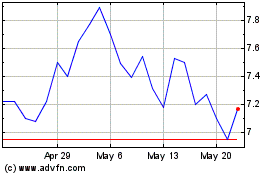
Aura Biosciences (NASDAQ:AURA)
Historical Stock Chart
From May 2023 to May 2024
